

Compact Muon Solenoid
LHC, CERN
| CMS-SMP-18-012 ; CERN-EP-2020-116 | ||
| Measurements of the W boson rapidity, helicity, double-differential cross sections, and charge asymmetry in pp collisions at 13 TeV | ||
| CMS Collaboration | ||
| 10 August 2020 | ||
| Phys. Rev. D 102 (2020) 092012 | ||
| Abstract: The differential cross section and charge asymmetry for inclusive W boson production at $\sqrt{s} = $ 13 TeV is measured for the two transverse polarization states as a function of the W boson absolute rapidity. The measurement uses events in which a W boson decays to a neutrino and either a muon or an electron. The data sample of proton-proton collisions recorded with the CMS detector at the LHC in 2016 corresponds to an integrated luminosity of 35.9 fb$^{-1}$. The differential cross section and its value normalized to the total inclusive W boson production cross section are measured over the rapidity range $|{y_{\mathrm{W}}}| < $ 2.5. In addition to the total fiducial cross section, the W boson double-differential cross section, ${\mathrm{d}}^2\sigma/{\mathrm{d}}{p_{\mathrm{T}}}^{\ell}{\mathrm{d}}|{\eta^{\ell}}| $, and the charge asymmetry are measured as functions of the charged lepton transverse momentum and pseudorapidity. The precision of these measurements is used to constrain the parton distribution functions of the proton using the next-to-leading order NNPDF3.0 set. | ||
| Links: e-print arXiv:2008.04174 [hep-ex] (PDF) ; CDS record ; inSPIRE record ; HepData record ; CADI line (restricted) ; | ||
| Figures & Tables | Summary | Additional Figures & Material | References | CMS Publications |
|---|
| Figures | |

png pdf |
Figure 1:
Generator-level distributions of the W boson ${{p_{\mathrm {T}}} ^{\mathrm{W}}}$ (top), ${{| y_{\mathrm{W}} |}}$ (center), and the resulting $\eta $ distribution of the charged lepton (bottom) after reweighting each of the helicity components for positively (left) and negatively (right) charged W bosons. |

png pdf |
Figure 1-a:
Generator-level distributions of the W boson ${{p_{\mathrm {T}}} ^{\mathrm{W}}}$ after reweighting each of the helicity components for positively charged W bosons. |

png pdf |
Figure 1-b:
Generator-level distributions of the W boson ${{p_{\mathrm {T}}} ^{\mathrm{W}}}$ after reweighting each of the helicity components for negatively charged W bosons. |

png pdf |
Figure 1-c:
Generator-level distributions of the W boson ${{| y_{\mathrm{W}} |}}$ after reweighting each of the helicity components for positively charged W bosons. |
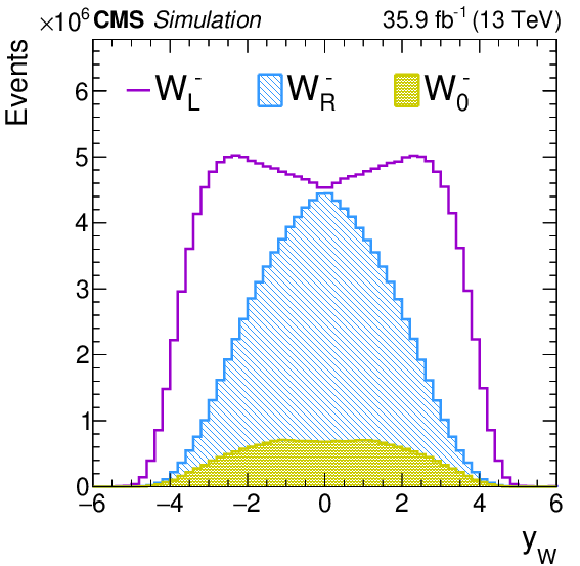
png pdf |
Figure 1-d:
Generator-level distributions of the W boson ${{| y_{\mathrm{W}} |}}$ after reweighting each of the helicity components for negatively charged W bosons. |
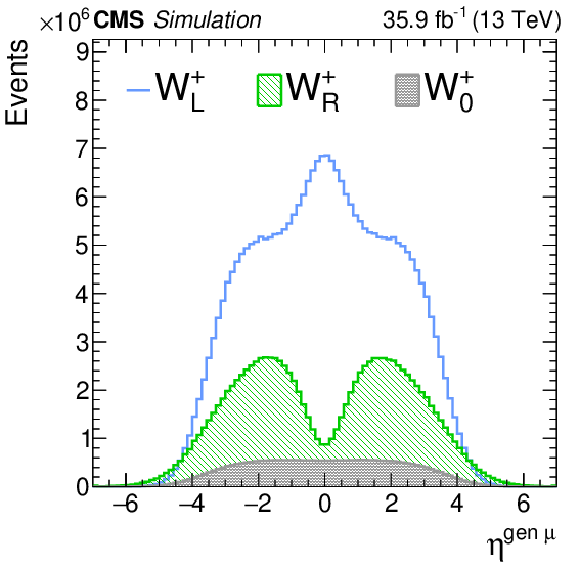
png pdf |
Figure 1-e:
$\eta $ distributions of the charged lepton after reweighting each of the helicity components for positively charged W bosons. |

png pdf |
Figure 1-f:
$\eta $ distributions of the charged lepton after reweighting each of the helicity components for negatively charged W bosons. |

png pdf |
Figure 2:
Distributions of 2D templates of ${{p_{\mathrm {T}}} ^{\ell}}$ versus ${\eta ^{\ell}}$, for simulated positively charged W bosons events in different helicity or rapidity bins. Templates for the muon channel are shown. Blue: ${\mathrm{W} ^+_\mathrm {R}}$ with $ {{| y_{\mathrm{W}} |}} < 0.25$, red: ${\mathrm{W} ^+_\mathrm {R}}$ with 0.50 $ < {{| y_{\mathrm{W}} |}} < $ 0.75, green: ${\mathrm{W} ^+_\mathrm {L}}$ with 2.00 $ < {{| y_{\mathrm{W}} |}} < $ 2.25. |
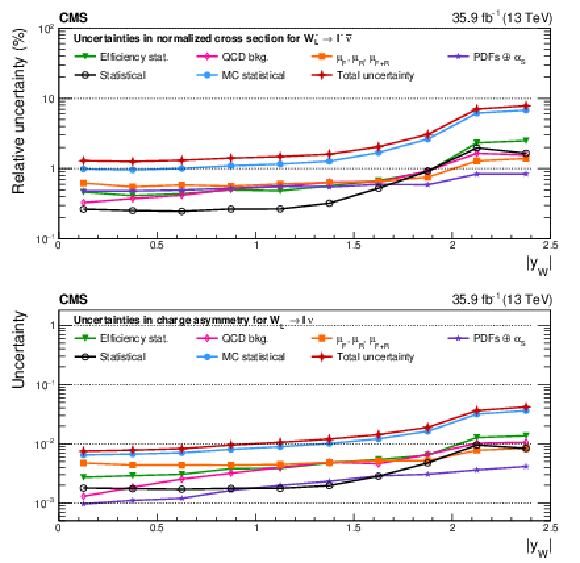
png pdf |
Figure 3:
Upper: relative impact of groups of uncertainties (as defined in the text) on the normalized signal cross sections as functions of the W boson rapidity for the ${\mathrm{W} ^-_\mathrm {L}}$ case. Lower: absolute impact of uncertainties on the charge asymmetry of the ${\mathrm{W} _\mathrm {L}}$ boson. All impacts are shown for the combination of the muon and electron channels in the helicity fit. The groups of uncertainties subleading to the ones shown are suppressed for simplicity. |

png pdf |
Figure 3-a:
Relative impact of groups of uncertainties (as defined in the text) on the normalized signal cross sections as functions of the W boson rapidity for the ${\mathrm{W} ^-_\mathrm {L}}$ case. All impacts are shown for the combination of the muon and electron channels in the helicity fit. The groups of uncertainties subleading to the ones shown are suppressed for simplicity. |

png pdf |
Figure 3-b:
Absolute impact of uncertainties on the charge asymmetry of the ${\mathrm{W} _\mathrm {L}}$ boson. All impacts are shown for the combination of the muon and electron channels in the helicity fit. The groups of uncertainties subleading to the ones shown are suppressed for simplicity. |

png pdf |
Figure 4:
Upper: relative impact of groups of systematic uncertainties (as defined in the text) on the normalized cross sections for the ${\mathrm{W^{+}}}$ case as functions of ${{| \eta ^{\ell} |}}$. Lower: relative impact of uncertainties on charge asymmetry. All impacts are shown for the combination of the muon and electron channels in the double-differential cross section fit. The groups of uncertainties subleading to the ones shown are suppressed for simplicity. |
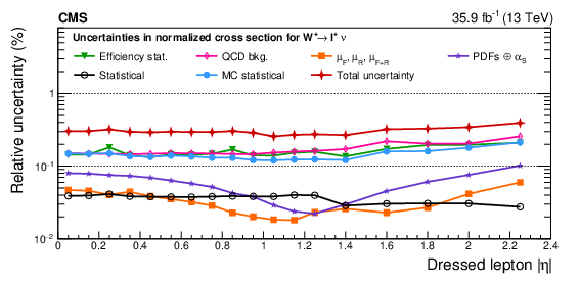
png pdf |
Figure 4-a:
Relative impact of groups of systematic uncertainties (as defined in the text) on the normalized cross sections for the ${\mathrm{W^{+}}}$ case as functions of ${{| \eta ^{\ell} |}}$. All impacts are shown for the combination of the muon and electron channels in the double-differential cross section fit. The groups of uncertainties subleading to the ones shown are suppressed for simplicity. |
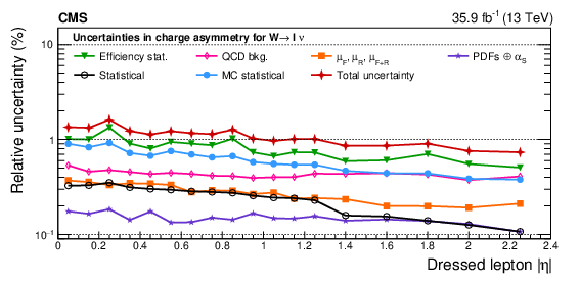
png pdf |
Figure 4-b:
Relative impact of uncertainties on charge asymmetry. All impacts are shown for the combination of the muon and electron channels in the double-differential cross section fit. The groups of uncertainties subleading to the ones shown are suppressed for simplicity. |
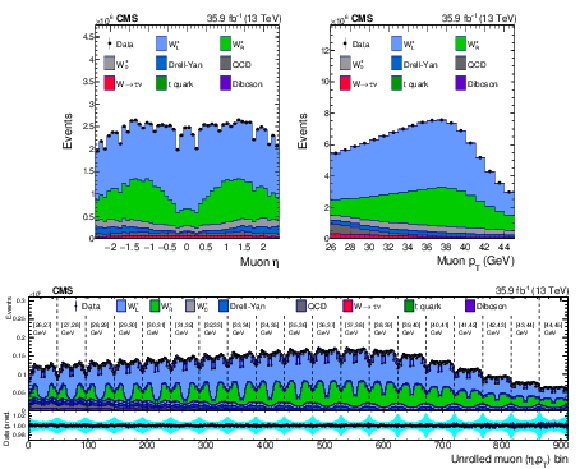
png pdf |
Figure 5:
Distributions of ${\eta ^{\mu}}$ (upper left), ${{p_{\mathrm {T}}} ^{\mu}}$ (upper right) and $\mathrm {bin_{unrolled}}$ (lower) for $ {\mathrm{W^{+}}} \to \mu ^+\nu $ events for observed data superimposed on signal plus background events. The signal and background processes are normalized to the result of the template fit. The cyan band over the data-to-prediction ratio represents the uncertainty in the total yield in each bin after the profiling process. |

png pdf |
Figure 5-a:
Distribution of ${\eta ^{\mu}}$ for $ {\mathrm{W^{+}}} \to \mu ^+\nu $ events for observed data superimposed on signal plus background events. The signal and background processes are normalized to the result of the template fit. The cyan band over the data-to-prediction ratio represents the uncertainty in the total yield in each bin after the profiling process. |

png pdf |
Figure 5-b:
Distribution of ${{p_{\mathrm {T}}} ^{\mu}}$ for $ {\mathrm{W^{+}}} \to \mu ^+\nu $ events for observed data superimposed on signal plus background events. The signal and background processes are normalized to the result of the template fit. The cyan band over the data-to-prediction ratio represents the uncertainty in the total yield in each bin after the profiling process. |

png pdf |
Figure 5-c:
Distribution of $\mathrm {bin_{unrolled}}$ for $ {\mathrm{W^{+}}} \to \mu ^+\nu $ events for observed data superimposed on signal plus background events. The signal and background processes are normalized to the result of the template fit. The cyan band over the data-to-prediction ratio represents the uncertainty in the total yield in each bin after the profiling process. |

png pdf |
Figure 6:
Distributions of ${\eta ^{\mu}}$ (upper left), ${{p_{\mathrm {T}}} ^{\mu}}$ (upper right) and $\mathrm {bin_{unrolled}}$ (lower) for $ {\mathrm{W^{-}}} \to \mu ^-\bar{\nu} $ events for observed data superimposed on signal plus background events. The signal and background processes are normalized to the result of the template fit. The cyan band over the data-to-prediction ratio represents the uncertainty in the total yield in each bin after the profiling process. |

png pdf |
Figure 6-a:
Distribution of ${\eta ^{\mu}}$ for $ {\mathrm{W^{-}}} \to \mu ^-\bar{\nu} $ events for observed data superimposed on signal plus background events. The signal and background processes are normalized to the result of the template fit. The cyan band over the data-to-prediction ratio represents the uncertainty in the total yield in each bin after the profiling process. |
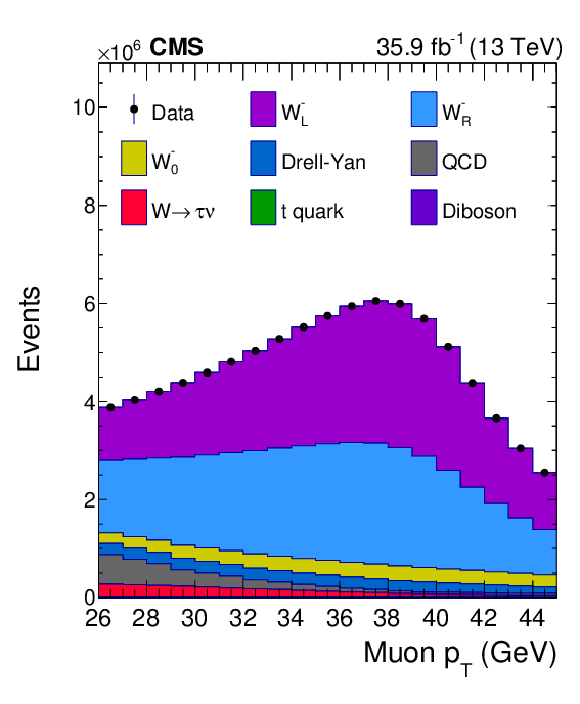
png pdf |
Figure 6-b:
Distribution of ${{p_{\mathrm {T}}} ^{\mu}}$ for $ {\mathrm{W^{-}}} \to \mu ^-\bar{\nu} $ events for observed data superimposed on signal plus background events. The signal and background processes are normalized to the result of the template fit. The cyan band over the data-to-prediction ratio represents the uncertainty in the total yield in each bin after the profiling process. |

png pdf |
Figure 6-c:
Distribution of $\mathrm {bin_{unrolled}}$ for $ {\mathrm{W^{-}}} \to \mu ^-\bar{\nu} $ events for observed data superimposed on signal plus background events. The signal and background processes are normalized to the result of the template fit. The cyan band over the data-to-prediction ratio represents the uncertainty in the total yield in each bin after the profiling process. |

png pdf |
Figure 7:
Distributions of ${\eta ^{\mathrm{e}}}$ (upper left), ${{p_{\mathrm {T}}} ^{\mathrm{e}}}$ (upper right) and $\mathrm {bin_{unrolled}}$ (lower) for $ {\mathrm{W^{+}}} \to \mathrm{e} ^+\nu $ events for observed data superimposed on signal plus background events. The signal and background processes are normalized to the result of the template fit. The cyan band over the data-to-prediction ratio represents the uncertainty in the total yield in each bin after the profiling process. |

png pdf |
Figure 7-a:
Distribution of $\mathrm {bin_{unrolled}}$ for $ {\mathrm{W^{+}}} \to \mathrm{e} ^+\nu $ events for observed data superimposed on signal plus background events. The signal and background processes are normalized to the result of the template fit. The cyan band over the data-to-prediction ratio represents the uncertainty in the total yield in each bin after the profiling process. |
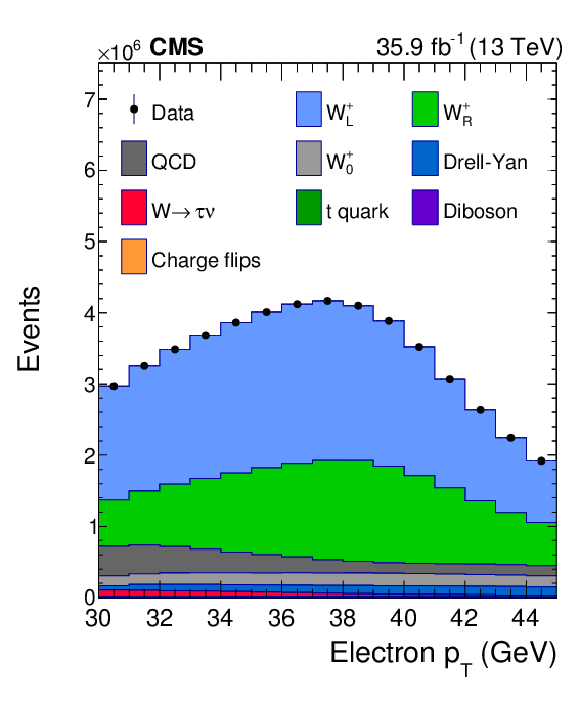
png pdf |
Figure 7-b:
Distributions of ${\eta ^{\mathrm{e}}}$ (upper left), ${{p_{\mathrm {T}}} ^{\mathrm{e}}}$ (upper right) and $\mathrm {bin_{unrolled}}$ (lower) for $ {\mathrm{W^{+}}} \to \mathrm{e} ^+\nu $ events for observed data superimposed on signal plus background events. The signal and background processes are normalized to the result of the template fit. The cyan band over the data-to-prediction ratio represents the uncertainty in the total yield in each bin after the profiling process. |

png pdf |
Figure 7-c:
Distributions of ${\eta ^{\mathrm{e}}}$ (upper left), ${{p_{\mathrm {T}}} ^{\mathrm{e}}}$ (upper right) and $\mathrm {bin_{unrolled}}$ (lower) for $ {\mathrm{W^{+}}} \to \mathrm{e} ^+\nu $ events for observed data superimposed on signal plus background events. The signal and background processes are normalized to the result of the template fit. The cyan band over the data-to-prediction ratio represents the uncertainty in the total yield in each bin after the profiling process. |
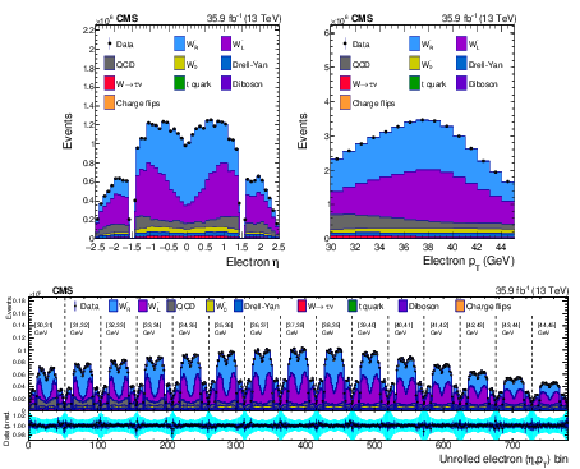
png pdf |
Figure 8:
Distributions of ${\eta ^{\mathrm{e}}}$ (upper left), ${{p_{\mathrm {T}}} ^{\mathrm{e}}}$ (upper right) and $\mathrm {bin_{unrolled}}$ (lower) for $ {\mathrm{W^{-}}} \to \mathrm{e} ^-\bar{\nu} $ events for observed data superimposed on signal plus background events. The signal and background processes are normalized to the result of the template fit. The cyan band over the data-to-prediction ratio represents the uncertainty in the total yield in each bin after the profiling process. |

png pdf |
Figure 8-a:
Distribution of ${\eta ^{\mathrm{e}}}$ for $ {\mathrm{W^{-}}} \to \mathrm{e} ^-\bar{\nu} $ events for observed data superimposed on signal plus background events. The signal and background processes are normalized to the result of the template fit. The cyan band over the data-to-prediction ratio represents the uncertainty in the total yield in each bin after the profiling process. |

png pdf |
Figure 8-b:
Distribution of ${{p_{\mathrm {T}}} ^{\mathrm{e}}}$ for $ {\mathrm{W^{-}}} \to \mathrm{e} ^-\bar{\nu} $ events for observed data superimposed on signal plus background events. The signal and background processes are normalized to the result of the template fit. The cyan band over the data-to-prediction ratio represents the uncertainty in the total yield in each bin after the profiling process. |

png pdf |
Figure 8-c:
Distribution of $\mathrm {bin_{unrolled}}$ for $ {\mathrm{W^{-}}} \to \mathrm{e} ^-\bar{\nu} $ events for observed data superimposed on signal plus background events. The signal and background processes are normalized to the result of the template fit. The cyan band over the data-to-prediction ratio represents the uncertainty in the total yield in each bin after the profiling process. |
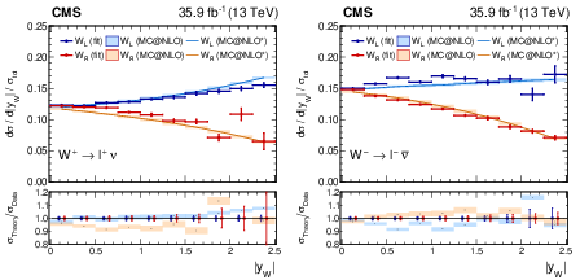
png pdf |
Figure 9:
Measured normalized $ {\mathrm{W^{+}}} \to \ell ^+\nu $ (left plot) or $ {\mathrm{W^{-}}} \to \ell ^-\bar{\nu} $ (right plot) cross section as functions of ${{| y_{\mathrm{W}} |}}$ for the left-handed and right-handed helicity states from the combination of the muon and electron channels, normalized to the total cross section. Also shown is the ratio of the prediction from MadGraph5_aMC@NLO to the data. The MadGraph5_aMC@NLO $^{*}$ spectrum stands for the prediction with the ${{p_{\mathrm {T}}} ^{\mathrm{W}}}$ weighting applied. The lightly-filled band corresponds to the expected uncertainty from the PDF variations, ${\mu _\mathrm {F}}$ and ${\mu _\mathrm {R}}$ scales, and ${\alpha _S}$. |

png pdf |
Figure 9-a:
Measured normalized $ {\mathrm{W^{+}}} \to \ell ^+\nu $ cross section as functions of ${{| y_{\mathrm{W}} |}}$ for the left-handed and right-handed helicity states from the combination of the muon and electron channels, normalized to the total cross section. Also shown is the ratio of the prediction from MadGraph5_aMC@NLO to the data. The MadGraph5_aMC@NLO $^{*}$ spectrum stands for the prediction with the ${{p_{\mathrm {T}}} ^{\mathrm{W}}}$ weighting applied. The lightly-filled band corresponds to the expected uncertainty from the PDF variations, ${\mu _\mathrm {F}}$ and ${\mu _\mathrm {R}}$ scales, and ${\alpha _S}$. |
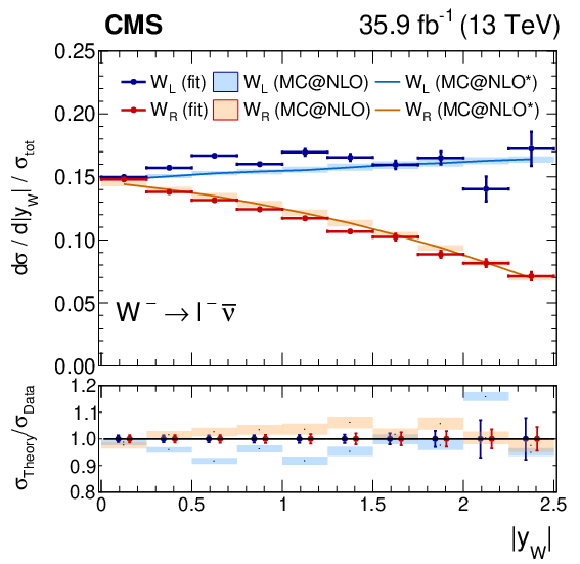
png pdf |
Figure 9-b:
Measured normalized $ {\mathrm{W^{-}}} \to \ell ^-\bar{\nu} $ cross section as functions of ${{| y_{\mathrm{W}} |}}$ for the left-handed and right-handed helicity states from the combination of the muon and electron channels, normalized to the total cross section. Also shown is the ratio of the prediction from MadGraph5_aMC@NLO to the data. The MadGraph5_aMC@NLO $^{*}$ spectrum stands for the prediction with the ${{p_{\mathrm {T}}} ^{\mathrm{W}}}$ weighting applied. The lightly-filled band corresponds to the expected uncertainty from the PDF variations, ${\mu _\mathrm {F}}$ and ${\mu _\mathrm {R}}$ scales, and ${\alpha _S}$. |
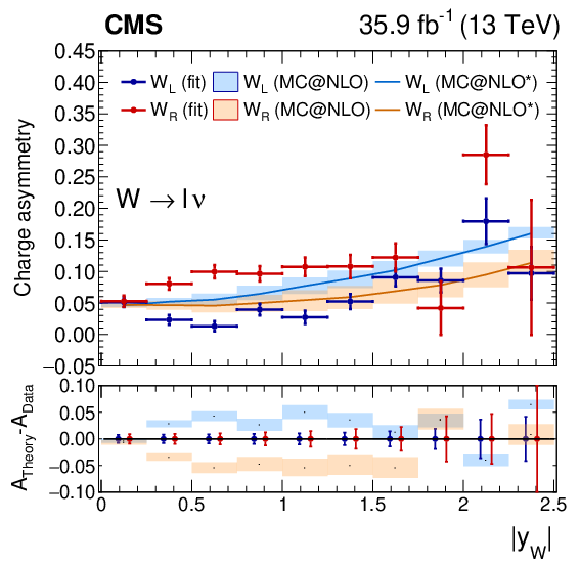
png pdf |
Figure 10:
Measured W boson charge asymmetry as functions of ${{| y_{\mathrm{W}} |}}$ for the left-handed and right-handed helicity states from the combination of the muon and electron channels. Also shown is the ratio of the prediction from MadGraph5_aMC@NLO to the data. The MadGraph5_aMC@NLO $^{*}$ spectrum stands for the prediction with the ${{p_{\mathrm {T}}} ^{\mathrm{W}}}$ weighting applied. The lightly-filled band corresponds to the expected uncertainty from the PDF variations, ${\mu _\mathrm {F}}$ and ${\mu _\mathrm {R}}$ scales, and ${\alpha _S}$. |

png pdf |
Figure 11:
Measured normalized $ {\mathrm{W^{+}}} \to \ell ^+\nu $ (left plot) and $ {\mathrm{W^{-}}} \to \ell ^-\bar{\nu} $ (right plot) cross section as a function of ${{| y_{\mathrm{W}} |}}$ from the combination of the muon and electron channels, normalized to the total cross section, integrated over the W polarization states. Also shown is the ratio of the prediction from MadGraph5_aMC@NLO to the data. The MadGraph5_aMC@NLO $^{*}$ spectrum stands for the prediction with the ${{p_{\mathrm {T}}} ^{\mathrm{W}}}$ weighting applied. The lightly-filled band corresponds to the expected uncertainty from the PDF variations, ${\mu _\mathrm {F}}$ and ${\mu _\mathrm {R}}$ scales, and ${\alpha _S}$. |

png pdf |
Figure 11-a:
Measured normalized $ {\mathrm{W^{+}}} \to \ell ^+\nu $ cross section as a function of ${{| y_{\mathrm{W}} |}}$ from the combination of the muon and electron channels, normalized to the total cross section, integrated over the W polarization states. Also shown is the ratio of the prediction from MadGraph5_aMC@NLO to the data. The MadGraph5_aMC@NLO $^{*}$ spectrum stands for the prediction with the ${{p_{\mathrm {T}}} ^{\mathrm{W}}}$ weighting applied. The lightly-filled band corresponds to the expected uncertainty from the PDF variations, ${\mu _\mathrm {F}}$ and ${\mu _\mathrm {R}}$ scales, and ${\alpha _S}$. |

png pdf |
Figure 11-b:
Measured normalized $ {\mathrm{W^{-}}} \to \ell ^-\bar{\nu} $ cross section as a function of ${{| y_{\mathrm{W}} |}}$ from the combination of the muon and electron channels, normalized to the total cross section, integrated over the W polarization states. Also shown is the ratio of the prediction from MadGraph5_aMC@NLO to the data. The MadGraph5_aMC@NLO $^{*}$ spectrum stands for the prediction with the ${{p_{\mathrm {T}}} ^{\mathrm{W}}}$ weighting applied. The lightly-filled band corresponds to the expected uncertainty from the PDF variations, ${\mu _\mathrm {F}}$ and ${\mu _\mathrm {R}}$ scales, and ${\alpha _S}$. |
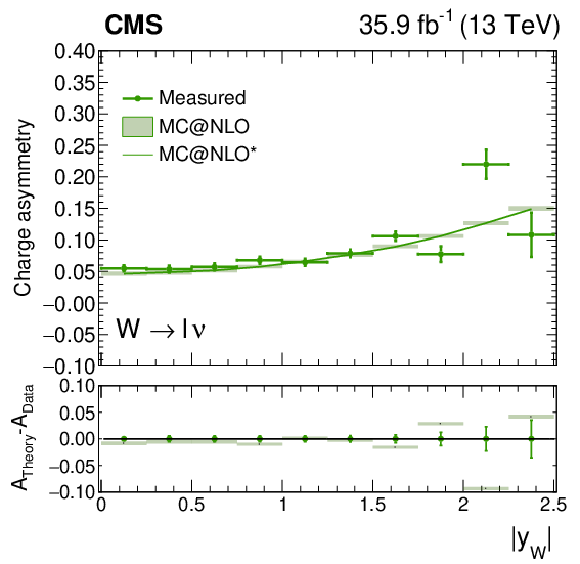
png pdf |
Figure 12:
Measured W charge asymmetry as a function of ${{| y_{\mathrm{W}} |}}$ from the combination of the muon and electron channels, integrated over the W polarization states. Also shown is the ratio of the prediction from MadGraph5_aMC@NLO to the data. The MadGraph5_aMC@NLO $^{*}$ spectrum stands for the prediction with the ${{p_{\mathrm {T}}} ^{\mathrm{W}}}$ weighting applied. The lightly-filled band corresponds to the expected uncertainty from the PDF variations, ${\mu _\mathrm {F}}$ and ${\mu _\mathrm {R}}$ scales, and ${\alpha _S}$. |
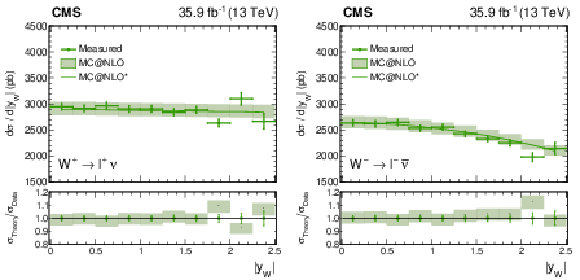
png pdf |
Figure 13:
Measured absolute $ {\mathrm{W^{+}}} \to \ell ^+\nu $ (left plot) or $ {\mathrm{W^{-}}} \to \ell ^-\bar{\nu} $ (right plot) cross section as functions of ${{| y_{\mathrm{W}} |}}$ from the combined flavor fit. The ratio of the prediction from MadGraph5_aMC@NLO to the data is also shown. The MadGraph5_aMC@NLO $^{*}$ spectrum stands for the prediction with the ${{p_{\mathrm {T}}} ^{\mathrm{W}}}$ weighting applied. The lightly-filled band corresponds to the expected uncertainty from the PDF variations, ${\mu _\mathrm {F}}$ and ${\mu _\mathrm {R}}$ scales, and ${\alpha _S}$. |

png pdf |
Figure 13-a:
Measured absolute $ {\mathrm{W^{+}}} \to \ell ^+\nu $ cross section as functions of ${{| y_{\mathrm{W}} |}}$ from the combined flavor fit. The ratio of the prediction from MadGraph5_aMC@NLO to the data is also shown. The MadGraph5_aMC@NLO $^{*}$ spectrum stands for the prediction with the ${{p_{\mathrm {T}}} ^{\mathrm{W}}}$ weighting applied. The lightly-filled band corresponds to the expected uncertainty from the PDF variations, ${\mu _\mathrm {F}}$ and ${\mu _\mathrm {R}}$ scales, and ${\alpha _S}$. |

png pdf |
Figure 13-b:
Measured absolute $ {\mathrm{W^{-}}} \to \ell ^-\bar{\nu} $ cross section as functions of ${{| y_{\mathrm{W}} |}}$ from the combined flavor fit. The ratio of the prediction from MadGraph5_aMC@NLO to the data is also shown. The MadGraph5_aMC@NLO $^{*}$ spectrum stands for the prediction with the ${{p_{\mathrm {T}}} ^{\mathrm{W}}}$ weighting applied. The lightly-filled band corresponds to the expected uncertainty from the PDF variations, ${\mu _\mathrm {F}}$ and ${\mu _\mathrm {R}}$ scales, and ${\alpha _S}$. |
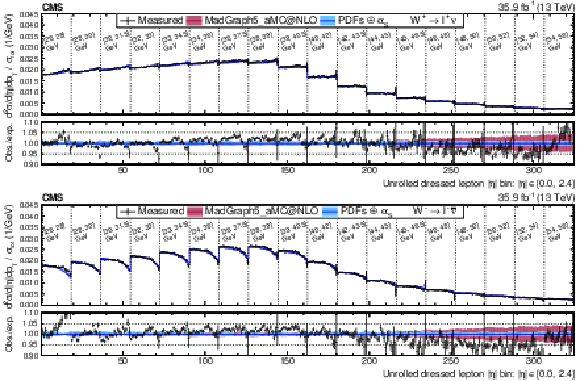
png pdf |
Figure 14:
Normalized double-differential cross section as a function of ${{p_{\mathrm {T}}} ^{\ell}}$ and ${{| \eta ^{\ell} |}}$, unrolled in a 1D histogram along ${{| \eta ^{\ell} |}}$ for the positive (negative) charge on the upper (lower) plot. The lower panel in each plot shows the ratio of the observed and expected cross sections. The colored bands represent the prediction from MadGraph5_aMC@NLO with the expected uncertainty from the quadrature sum of the PDF$\oplus {\alpha _S} $ variations (blue) and the ${\mu _\mathrm {F}}$ and ${\mu _\mathrm {R}}$ scales (bordeaux). |

png pdf |
Figure 14-a:
Normalized double-differential cross section as a function of ${{p_{\mathrm {T}}} ^{\ell}}$ and ${{| \eta ^{\ell} |}}$, unrolled in a 1D histogram along ${{| \eta ^{\ell} |}}$ for the positive charge. The lower panelshows the ratio of the observed and expected cross sections. The colored bands represent the prediction from MadGraph5_aMC@NLO with the expected uncertainty from the quadrature sum of the PDF$\oplus {\alpha _S} $ variations (blue) and the ${\mu _\mathrm {F}}$ and ${\mu _\mathrm {R}}$ scales (bordeaux). |

png pdf |
Figure 14-b:
Normalized double-differential cross section as a function of ${{p_{\mathrm {T}}} ^{\ell}}$ and ${{| \eta ^{\ell} |}}$, unrolled in a 1D histogram along ${{| \eta ^{\ell} |}}$ for the negative charge. The lower panelshows the ratio of the observed and expected cross sections. The colored bands represent the prediction from MadGraph5_aMC@NLO with the expected uncertainty from the quadrature sum of the PDF$\oplus {\alpha _S} $ variations (blue) and the ${\mu _\mathrm {F}}$ and ${\mu _\mathrm {R}}$ scales (bordeaux). |

png pdf |
Figure 15:
Double-differential W boson charge asymmetry as a function of ${{p_{\mathrm {T}}} ^{\ell}}$ and ${{| \eta ^{\ell} |}}$, unrolled in a 1D histogram along ${{| \eta ^{\ell} |}}$. The lower panel shows the difference of the observed and expected charge asymmetry. The colored bands represent the prediction from MadGraph5_aMC@NLO with the expected uncertainty from the quadrature sum of the PDF$\oplus {\alpha _S} $ variations (blue) and the ${\mu _\mathrm {F}}$ and ${\mu _\mathrm {R}}$ scales (bordeaux). |

png pdf |
Figure 16:
Absolute double-differential cross section as a function of ${{p_{\mathrm {T}}} ^{\ell}}$ and ${{| \eta ^{\ell} |}}$, unrolled in a 1D histogram along ${{p_{\mathrm {T}}} ^{\ell}}$ in bins of ${{| \eta ^{\ell} |}}$ for the positive (negative) charge on upper (lower) panel. The combined muon and electron fit is shown in green markers, the muon-only fit in blue markers, and the electron-only fit in red markers. The error bars correspond to the total uncertainty from the respective fits. The filled gray band in the lower panel represents the total uncertainty from the combined fit. |

png pdf |
Figure 16-a:
Absolute double-differential cross section as a function of ${{p_{\mathrm {T}}} ^{\ell}}$ and ${{| \eta ^{\ell} |}}$, unrolled in a 1D histogram along ${{p_{\mathrm {T}}} ^{\ell}}$ in bins of ${{| \eta ^{\ell} |}}$ for the positive charge. The combined muon and electron fit is shown in green markers, the muon-only fit in blue markers, and the electron-only fit in red markers. The error bars correspond to the total uncertainty from the respective fits. The filled gray band in the lower panel represents the total uncertainty from the combined fit. |

png pdf |
Figure 16-b:
Absolute double-differential cross section as a function of ${{p_{\mathrm {T}}} ^{\ell}}$ and ${{| \eta ^{\ell} |}}$, unrolled in a 1D histogram along ${{p_{\mathrm {T}}} ^{\ell}}$ in bins of ${{| \eta ^{\ell} |}}$ for the negative charge. The combined muon and electron fit is shown in green markers, the muon-only fit in blue markers, and the electron-only fit in red markers. The error bars correspond to the total uncertainty from the respective fits. The filled gray band in the lower panel represents the total uncertainty from the combined fit. |

png pdf |
Figure 17:
Absolute differential cross section as a function of ${{| \eta ^{\ell} |}}$ for the ${\mathrm{W^{+}} \to \ell ^+\nu}$ (left) and ${\mathrm{W^{-}} \to \ell ^-\bar{\nu}}$ channel (right). The measurement is the result of the combination of the muon and electron channels. The lower panel in each plot shows the ratio of observed and expected cross section. The colored bands represent the prediction from MadGraph5_aMC@NLO with the expected uncertainty from the quadrature sum of the PDF$\oplus {\alpha _S} $ variations (blue) and the ${\mu _\mathrm {F}}$ and ${\mu _\mathrm {R}}$ scales (bordeaux). |
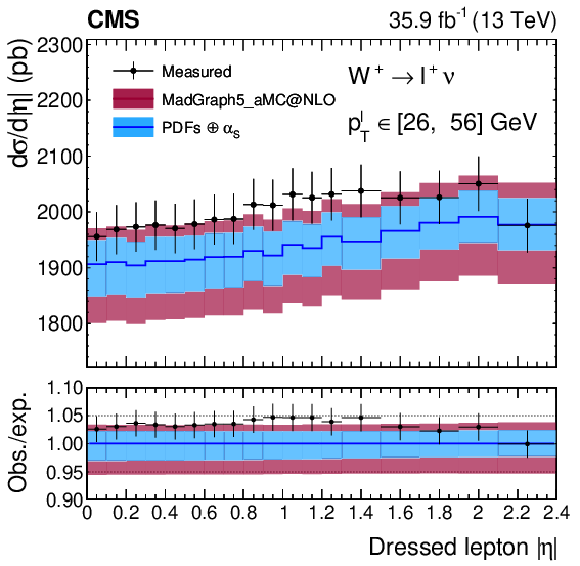
png pdf |
Figure 17-a:
Absolute differential cross section as a function of ${{| \eta ^{\ell} |}}$ for the ${\mathrm{W^{+}} \to \ell ^+\nu}$ channel. The measurement is the result of the combination of the muon and electron channels. The lower panel shows the ratio of observed and expected cross section. The colored bands represent the prediction from MadGraph5_aMC@NLO with the expected uncertainty from the quadrature sum of the PDF$\oplus {\alpha _S} $ variations (blue) and the ${\mu _\mathrm {F}}$ and ${\mu _\mathrm {R}}$ scales (bordeaux). |
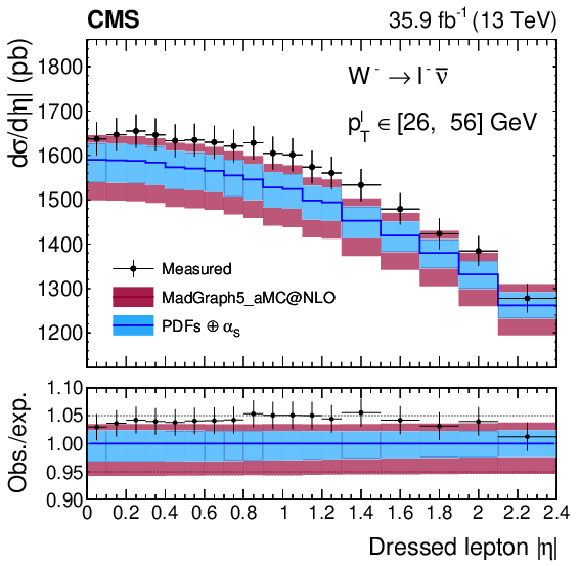
png pdf |
Figure 17-b:
Absolute differential cross section as a function of ${{| \eta ^{\ell} |}}$ for the ${\mathrm{W^{-}} \to \ell ^-\bar{\nu}}$ channel. The measurement is the result of the combination of the muon and electron channels. The lower panel shows the ratio of observed and expected cross section. The colored bands represent the prediction from MadGraph5_aMC@NLO with the expected uncertainty from the quadrature sum of the PDF$\oplus {\alpha _S} $ variations (blue) and the ${\mu _\mathrm {F}}$ and ${\mu _\mathrm {R}}$ scales (bordeaux). |
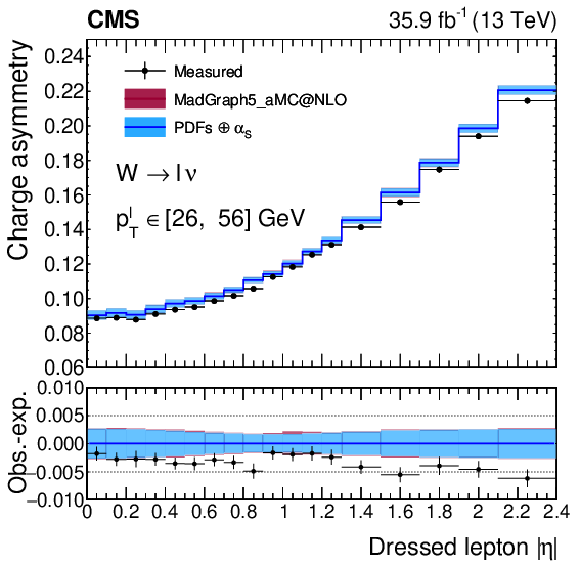
png pdf |
Figure 18:
Absolute differential W boson charge asymmetry as a function of ${{| \eta ^{\ell} |}}$. The measurement is the result of the combination of the muon and electron channels. The lower panel shows the difference of observed and expected charge asymmetry. The colored bands represent the prediction from MadGraph5_aMC@NLO with the expected uncertainty from the quadrature sum of the PDF$\oplus {\alpha _S} $ variations (blue) and the ${\mu _\mathrm {F}}$ and ${\mu _\mathrm {R}}$ scales (bordeaux). |

png pdf |
Figure 19:
Ratio of the measured over predicted absolute inclusive cross section in the fiducial region 26 $ < {{p_{\mathrm {T}}} ^{\ell}} < $ 56 GeV and $ {{| \eta ^{\ell} |}} < $ 2.5, charge-integrated, charge-dependent, and the ratio for ${\mathrm{W^{+}}}$ and ${\mathrm{W^{-}}}$. The measurement is the result of the combination of the muon and electron channels. The colored bands represent the prediction from MadGraph5_aMC@NLO with the expected uncertainty from the quadrature sum of the PDF$\oplus {\alpha _S} $ variations (blue) and the ${\mu _\mathrm {F}}$ and ${\mu _\mathrm {R}}$ scales (bordeaux). |

png pdf |
Figure 20:
Pulls and constraints of the 60 Hessian variations of the NNPDF3.0 PDF set, and of the ${\alpha _S}$ parameter, from the combined fit of muon and electron channels. The underlying fit is performed by fixing the W boson cross sections to their expectation in all helicity and charge processes. The cyan band represents the input values (which all have zero mean and width one), the orange bands show the post-fit expected values, and black points represent the observed pulls and constraint values. |
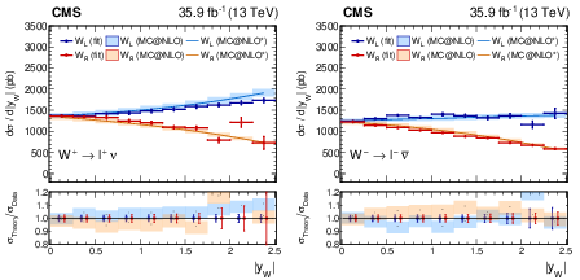
png pdf |
Figure A1:
Measured absolute $ {\mathrm{W^{+}}} \to \ell ^+\nu $ (left) and $ {\mathrm{W^{-}}} \to \ell ^-\bar{\nu} $ (right) cross section as a function of ${{| y_{\mathrm{W}} |}}$ for the left-handed and right-handed helicity states from the combination of muon and electron channels. The ratio of the prediction from MadGraph5_aMC@NLO to the data is also shown. The lightly-filled band corresponds to the expected uncertainty from the PDF variations, ${\mu _\mathrm {F}}$ and ${\mu _\mathrm {R}}$ scales, and ${\alpha _S}$. |
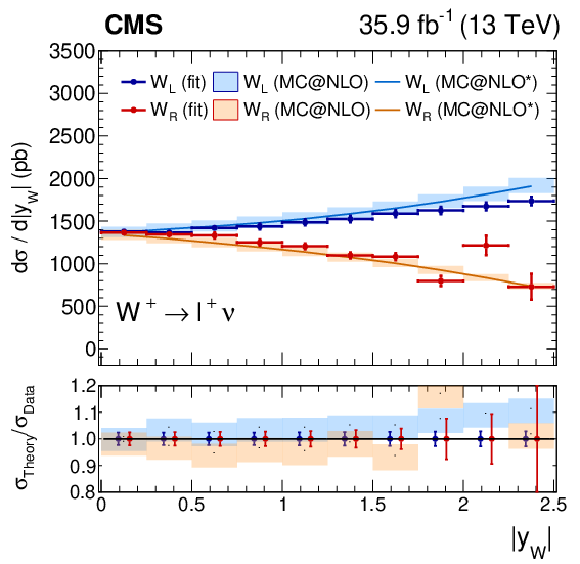
png pdf |
Figure A1-a:
Measured absolute $ {\mathrm{W^{+}}} \to \ell ^+\nu $ (left) and $ {\mathrm{W^{-}}} \to \ell ^-\bar{\nu} $ (right) cross section as a function of ${{| y_{\mathrm{W}} |}}$ for the left-handed and right-handed helicity states from the combination of muon and electron channels. The ratio of the prediction from MadGraph5_aMC@NLO to the data is also shown. The lightly-filled band corresponds to the expected uncertainty from the PDF variations, ${\mu _\mathrm {F}}$ and ${\mu _\mathrm {R}}$ scales, and ${\alpha _S}$. |

png pdf |
Figure A1-b:
Measured absolute $ {\mathrm{W^{+}}} \to \ell ^+\nu $ (left) and $ {\mathrm{W^{-}}} \to \ell ^-\bar{\nu} $ (right) cross section as a function of ${{| y_{\mathrm{W}} |}}$ for the left-handed and right-handed helicity states from the combination of muon and electron channels. The ratio of the prediction from MadGraph5_aMC@NLO to the data is also shown. The lightly-filled band corresponds to the expected uncertainty from the PDF variations, ${\mu _\mathrm {F}}$ and ${\mu _\mathrm {R}}$ scales, and ${\alpha _S}$. |
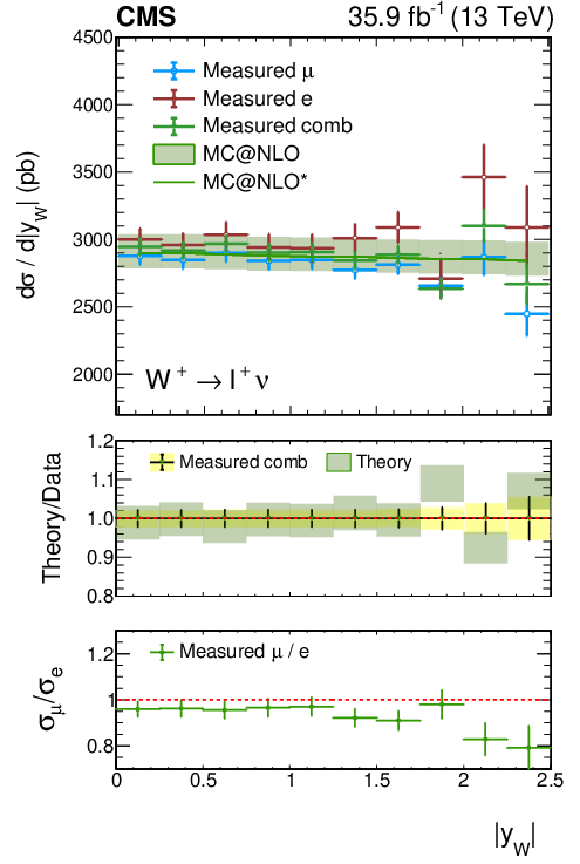
png pdf |
Figure A2:
Measured absolute $ {\mathrm{W^{+}}} \to \ell ^+\nu $ cross section as a function of ${{| y_{\mathrm{W}} |}}$ from three distinct fits: the combination of muon and electron channels (green), the muon-only fit (blue), and the electron-only fit (red). The ratio of the prediction from MadGraph5_aMC@NLO to the data is also shown. The lightly-filled band corresponds to the expected uncertainty from the PDF variations, ${\mu _\mathrm {F}}$ and ${\mu _\mathrm {R}}$ scales, and ${\alpha _S}$. |

png pdf |
Figure A3:
Measured absolute $ {\mathrm{W^{-}}} \to \ell ^-\bar{\nu} $ cross section as a function of ${{| y_{\mathrm{W}} |}}$ from three distinct fits: the combination of muon and electron channels (green), the muon-only fit (blue), and the electron-only fit (red). The ratio of the prediction from MadGraph5_aMC@NLO to the data is also shown. The lightly-filled band corresponds to the expected uncertainty from the PDF variations, ${\mu _\mathrm {F}}$ and ${\mu _\mathrm {R}}$ scales, and ${\alpha _S}$. |

png pdf |
Figure A4:
Measured W boson charge asymmetry as a function of ${{| y_{\mathrm{W}} |}}$ from the combination of the muon and electron channels (black dots), compared with different theoretical predictions. The yellow band represents the default generator used in this analysis, MadGraph5_aMC@NLO with NNPDF3.0 PDF set, the pink band represents the {fewz} generator with NNPDF3.1 PDF set, and the cyan band represents the {fewz} generator with CT18 PDF set. The uncertainty bands of the prediction include PDF uncertainties only, which are dominant with respect to ${\alpha _S}$ or QCD scale variations for this quantity. |
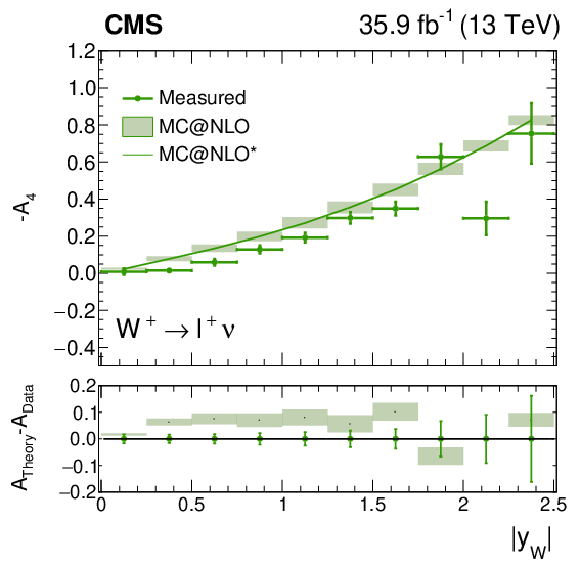
png pdf |
Figure A5:
Measured $A_4$ coefficient for $ {\mathrm{W^{+}}} \to \ell ^+\nu $ extracted from the fit of the polarized cross sections to the combined muon and electron channel fit. Note that $A_4$ is negative in this case, and the plotted quantity is $-A_4$. The difference between the prediction from MadGraph5_aMC@NLO and the measured values is also shown. The lightly-filled band corresponds to the expected uncertainty from the PDF variations, ${\mu _\mathrm {F}}$ and ${\mu _\mathrm {R}}$ scales, and ${\alpha _S}$. |
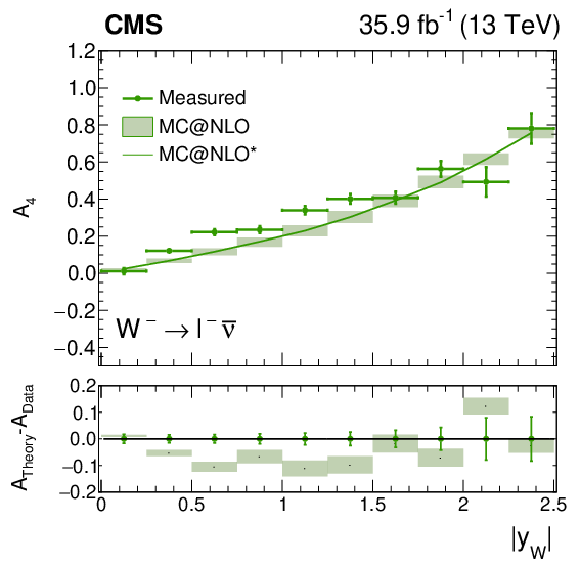
png pdf |
Figure A6:
Measured $A_4$ coefficient for $ {\mathrm{W^{-}}} \to \ell ^-\nu $ extracted from the fit of the polarized cross sections to the combined muon and electron channel fit. The difference between the prediction from MadGraph5_aMC@NLO and the measured values is also shown. The lightly-filled band corresponds to the expected uncertainty from the PDF variations, ${\mu _\mathrm {F}}$ and ${\mu _\mathrm {R}}$ scales, and ${\alpha _S}$. |

png pdf |
Figure A7:
Correlation coefficients between the helicity-dependent signal cross sections for $ {\mathrm{W^{+}}} \to \ell ^+\nu $ (left) and $ {\mathrm{W^{-}}} \to \ell ^-\bar{\nu} $ (right) extracted from the fit to the combined muon and electron channel fit. |

png pdf |
Figure A7-a:
Correlation coefficients between the helicity-dependent signal cross sections for $ {\mathrm{W^{+}}} \to \ell ^+\nu $ (left) and $ {\mathrm{W^{-}}} \to \ell ^-\bar{\nu} $ (right) extracted from the fit to the combined muon and electron channel fit. |

png pdf |
Figure A7-b:
Correlation coefficients between the helicity-dependent signal cross sections for $ {\mathrm{W^{+}}} \to \ell ^+\nu $ (left) and $ {\mathrm{W^{-}}} \to \ell ^-\bar{\nu} $ (right) extracted from the fit to the combined muon and electron channel fit. |

png pdf |
Figure A8:
Correlation coefficients between the 60 PDF nuisance parameters extracted from the fit to the combined muon and electron channel fit. The underlying fit is performed by fixing the W boson cross sections to their expectation in all helicity and charge processes. |

png pdf |
Figure A9:
Post-fit pulls and constraints of the nuisance parameters associated with the ${\mu _\mathrm {F}}$ and ${\mu _\mathrm {R}}$ scale systematic uncertainties. The numbering refers to bins in the ${{p_{\mathrm {T}}} ^{\mathrm{W}}}$ spectrum in increasing order. The nuisance parameters applied to the "left'' polarization are shown on the upper panel while the ones associated with the "right'' polarization are shown on the lower panel. |

png pdf |
Figure A9-a:
Post-fit pulls and constraints of the nuisance parameters associated with the ${\mu _\mathrm {F}}$ and ${\mu _\mathrm {R}}$ scale systematic uncertainties. The numbering refers to bins in the ${{p_{\mathrm {T}}} ^{\mathrm{W}}}$ spectrum in increasing order. The nuisance parameters applied to the "left'' polarization are shown on the upper panel while the ones associated with the "right'' polarization are shown on the lower panel. |
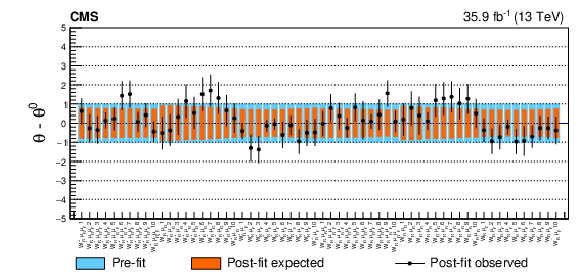
png pdf |
Figure A9-b:
Post-fit pulls and constraints of the nuisance parameters associated with the ${\mu _\mathrm {F}}$ and ${\mu _\mathrm {R}}$ scale systematic uncertainties. The numbering refers to bins in the ${{p_{\mathrm {T}}} ^{\mathrm{W}}}$ spectrum in increasing order. The nuisance parameters applied to the "left'' polarization are shown on the upper panel while the ones associated with the "right'' polarization are shown on the lower panel. |
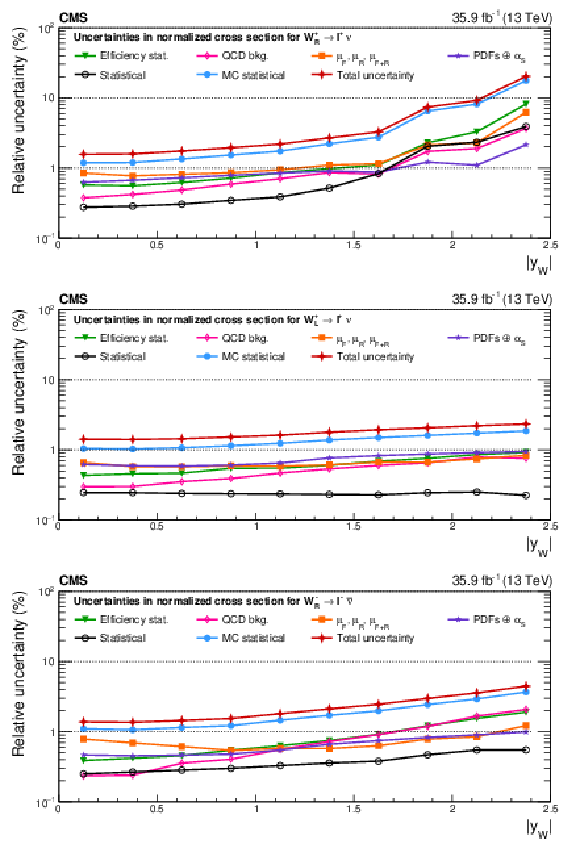
png pdf |
Figure A10:
Remaining impacts on the normalized polarized cross sections as functions of the W boson rapidity. Shown are the impacts of the nuisance groups for ${\mathrm{W} ^+_\mathrm {R}}$ (upper), ${\mathrm{W} ^+_\mathrm {L}}$ (middle), and ${\mathrm{W} ^-_\mathrm {R}}$ (lower) bosons in the helicity fit. The groups of uncertainties subleading to the ones shown are suppressed for simplicity. |
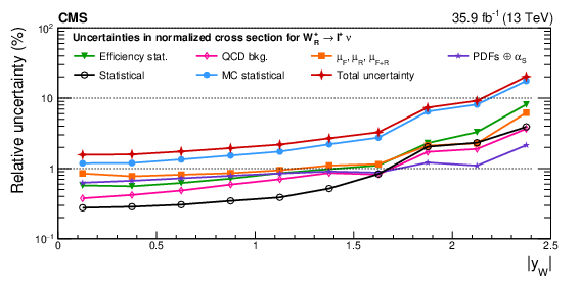
png pdf |
Figure A10-a:
Remaining impacts on the normalized polarized cross sections as functions of the W boson rapidity. Shown are the impacts of the nuisance groups for ${\mathrm{W} ^+_\mathrm {R}}$ (upper), ${\mathrm{W} ^+_\mathrm {L}}$ (middle), and ${\mathrm{W} ^-_\mathrm {R}}$ (lower) bosons in the helicity fit. The groups of uncertainties subleading to the ones shown are suppressed for simplicity. |
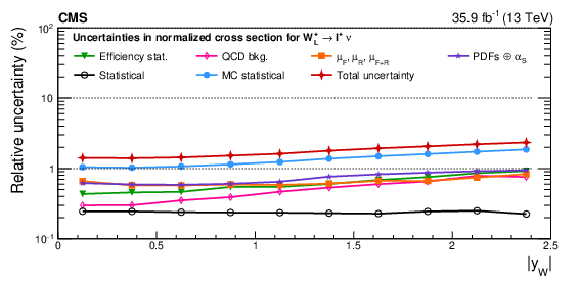
png pdf |
Figure A10-b:
Remaining impacts on the normalized polarized cross sections as functions of the W boson rapidity. Shown are the impacts of the nuisance groups for ${\mathrm{W} ^+_\mathrm {R}}$ (upper), ${\mathrm{W} ^+_\mathrm {L}}$ (middle), and ${\mathrm{W} ^-_\mathrm {R}}$ (lower) bosons in the helicity fit. The groups of uncertainties subleading to the ones shown are suppressed for simplicity. |

png pdf |
Figure A10-c:
Remaining impacts on the normalized polarized cross sections as functions of the W boson rapidity. Shown are the impacts of the nuisance groups for ${\mathrm{W} ^+_\mathrm {R}}$ (upper), ${\mathrm{W} ^+_\mathrm {L}}$ (middle), and ${\mathrm{W} ^-_\mathrm {R}}$ (lower) bosons in the helicity fit. The groups of uncertainties subleading to the ones shown are suppressed for simplicity. |

png pdf |
Figure A11:
Impacts on the absolute polarized cross sections as functions of the W boson rapidity. Shown are the impacts of the nuisance groups for ${\mathrm{W} ^+_\mathrm {L}}$ (upper) and ${\mathrm{W} ^+_\mathrm {R}}$ (lower) in the helicity fit. The groups of uncertainties subleading to the ones shown are suppressed for simplicity. |

png pdf |
Figure A11-a:
Impacts on the absolute polarized cross sections as functions of the W boson rapidity. Shown are the impacts of the nuisance groups for ${\mathrm{W} ^+_\mathrm {L}}$ (upper) and ${\mathrm{W} ^+_\mathrm {R}}$ (lower) in the helicity fit. The groups of uncertainties subleading to the ones shown are suppressed for simplicity. |

png pdf |
Figure A11-b:
Impacts on the absolute polarized cross sections as functions of the W boson rapidity. Shown are the impacts of the nuisance groups for ${\mathrm{W} ^+_\mathrm {L}}$ (upper) and ${\mathrm{W} ^+_\mathrm {R}}$ (lower) in the helicity fit. The groups of uncertainties subleading to the ones shown are suppressed for simplicity. |

png pdf |
Figure A12:
Impacts on the absolute polarized cross sections as functions of the W boson rapidity. Shown are the impacts of the nuisance groups for ${\mathrm{W} ^-_\mathrm {L}}$ (upper) and ${\mathrm{W} ^-_\mathrm {R}}$ (lower) bosons in the helicity fit. The groups of uncertainties subleading to the ones shown are suppressed for simplicity. |

png pdf |
Figure A12-a:
Impacts on the absolute polarized cross sections as functions of the W boson rapidity. Shown are the impacts of the nuisance groups for ${\mathrm{W} ^-_\mathrm {L}}$ (upper) and ${\mathrm{W} ^-_\mathrm {R}}$ (lower) bosons in the helicity fit. The groups of uncertainties subleading to the ones shown are suppressed for simplicity. |
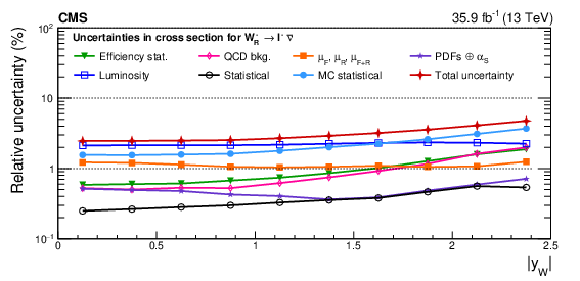
png pdf |
Figure A12-b:
Impacts on the absolute polarized cross sections as functions of the W boson rapidity. Shown are the impacts of the nuisance groups for ${\mathrm{W} ^-_\mathrm {L}}$ (upper) and ${\mathrm{W} ^-_\mathrm {R}}$ (lower) bosons in the helicity fit. The groups of uncertainties subleading to the ones shown are suppressed for simplicity. |
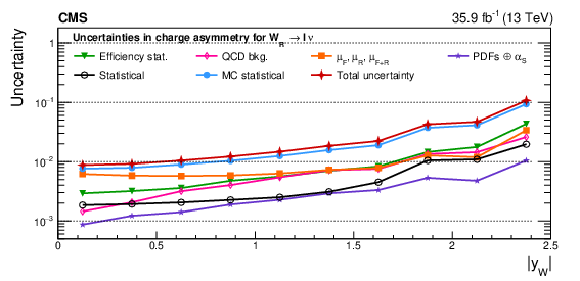
png pdf |
Figure A13:
Impacts on the charge asymmetry as functions of the W boson rapidity for ${\mathrm{W} _\mathrm {R}}$ bosons in the helicity fit. The groups of uncertainties subleading to the ones shown are suppressed for simplicity. |

png pdf |
Figure A14:
Impacts on the unpolarized absolute cross sections as functions of the W boson rapidity for ${\mathrm{W^{+}}}$ (upper), ${\mathrm{W^{-}}}$ (middle), and the unpolarized charge asymmetry (lower) bosons in the helicity fit. The groups of uncertainties subleading to the ones shown are suppressed for simplicity. |
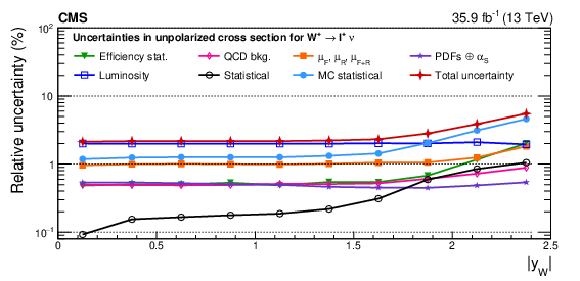
png pdf |
Figure A14-a:
Impacts on the unpolarized absolute cross sections as functions of the W boson rapidity for ${\mathrm{W^{+}}}$ (upper), ${\mathrm{W^{-}}}$ (middle), and the unpolarized charge asymmetry (lower) bosons in the helicity fit. The groups of uncertainties subleading to the ones shown are suppressed for simplicity. |
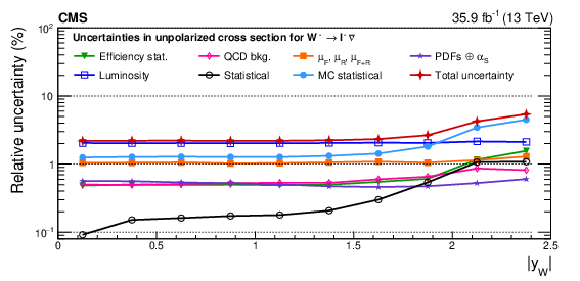
png pdf |
Figure A14-b:
Impacts on the unpolarized absolute cross sections as functions of the W boson rapidity for ${\mathrm{W^{+}}}$ (upper), ${\mathrm{W^{-}}}$ (middle), and the unpolarized charge asymmetry (lower) bosons in the helicity fit. The groups of uncertainties subleading to the ones shown are suppressed for simplicity. |

png pdf |
Figure A14-c:
Impacts on the unpolarized absolute cross sections as functions of the W boson rapidity for ${\mathrm{W^{+}}}$ (upper), ${\mathrm{W^{-}}}$ (middle), and the unpolarized charge asymmetry (lower) bosons in the helicity fit. The groups of uncertainties subleading to the ones shown are suppressed for simplicity. |

png pdf |
Figure A15:
Impacts on the unpolarized normalized cross sections as functions of the W boson rapidity for ${\mathrm{W^{+}}}$ (upper) and ${\mathrm{W^{-}}}$ (lower) bosons in the helicity fit. The groups of uncertainties subleading to the ones shown are suppressed for simplicity. |

png pdf |
Figure A15-a:
Impacts on the unpolarized normalized cross sections as functions of the W boson rapidity for ${\mathrm{W^{+}}}$ (upper) and ${\mathrm{W^{-}}}$ (lower) bosons in the helicity fit. The groups of uncertainties subleading to the ones shown are suppressed for simplicity. |
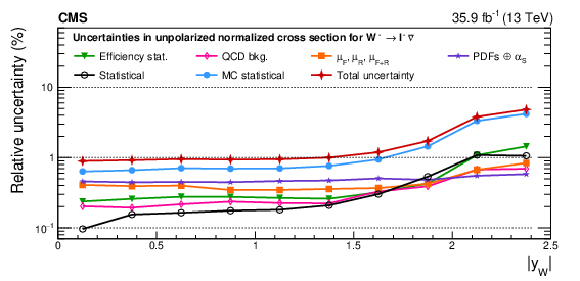
png pdf |
Figure A15-b:
Impacts on the unpolarized normalized cross sections as functions of the W boson rapidity for ${\mathrm{W^{+}}}$ (upper) and ${\mathrm{W^{-}}}$ (lower) bosons in the helicity fit. The groups of uncertainties subleading to the ones shown are suppressed for simplicity. |
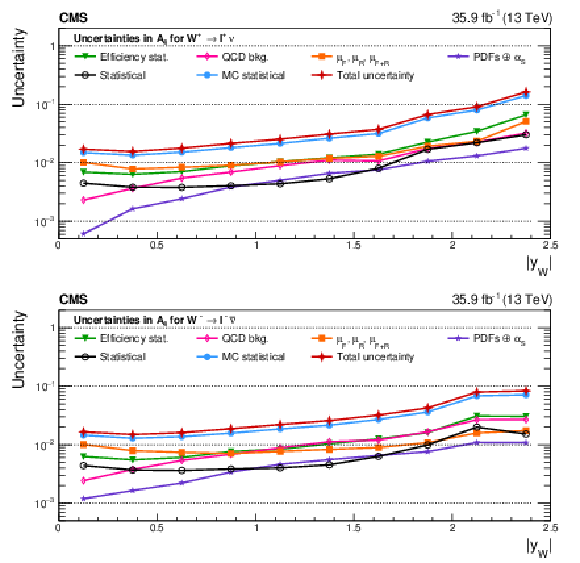
png pdf |
Figure A16:
Impacts on the A$_4$ coefficient as functions of the W boson rapidity for ${\mathrm{W^{+}}}$ (upper) and ${\mathrm{W^{-}}}$ (lower) bosons in the helicity fit. The groups of uncertainties subleading to the ones shown are suppressed for simplicity. |
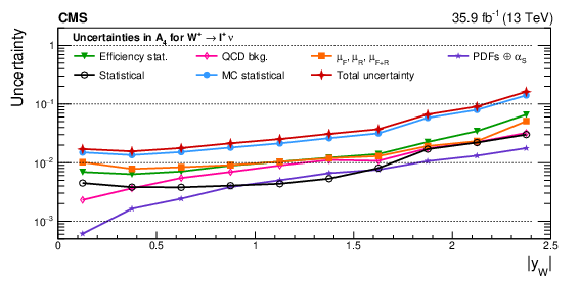
png pdf |
Figure A16-a:
Impacts on the A$_4$ coefficient as functions of the W boson rapidity for ${\mathrm{W^{+}}}$ (upper) and ${\mathrm{W^{-}}}$ (lower) bosons in the helicity fit. The groups of uncertainties subleading to the ones shown are suppressed for simplicity. |

png pdf |
Figure A16-b:
Impacts on the A$_4$ coefficient as functions of the W boson rapidity for ${\mathrm{W^{+}}}$ (upper) and ${\mathrm{W^{-}}}$ (lower) bosons in the helicity fit. The groups of uncertainties subleading to the ones shown are suppressed for simplicity. |
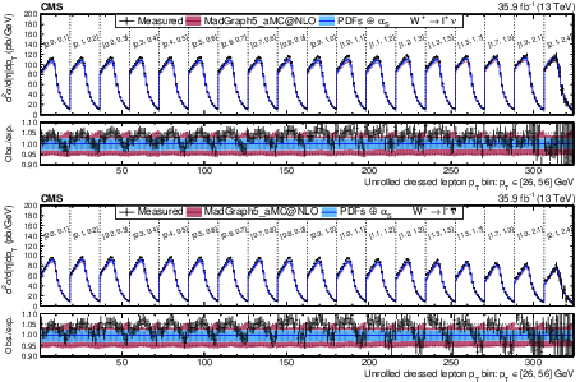
png pdf |
Figure A17:
Unrolled cross sections for the combined muon and electron channel fit unrolled along ${{p_{\mathrm {T}}} ^{\ell}}$ in bins of ${{| \eta ^{\ell} |}}$ for ${\mathrm{W^{+}}}$ (upper) and ${\mathrm{W^{-}}}$ (lower) bosons. The colored bands represent the prediction from MadGraph5_aMC@NLO with the expected uncertainty from the quadrature sum of the PDF$\oplus {\alpha _S} $ variations (blue) and the ${\mu _\mathrm {F}}$ and ${\mu _\mathrm {R}}$ scales (bordeaux). |

png pdf |
Figure A17-a:
Unrolled cross sections for the combined muon and electron channel fit unrolled along ${{p_{\mathrm {T}}} ^{\ell}}$ in bins of ${{| \eta ^{\ell} |}}$ for ${\mathrm{W^{+}}}$ (upper) and ${\mathrm{W^{-}}}$ (lower) bosons. The colored bands represent the prediction from MadGraph5_aMC@NLO with the expected uncertainty from the quadrature sum of the PDF$\oplus {\alpha _S} $ variations (blue) and the ${\mu _\mathrm {F}}$ and ${\mu _\mathrm {R}}$ scales (bordeaux). |

png pdf |
Figure A17-b:
Unrolled cross sections for the combined muon and electron channel fit unrolled along ${{p_{\mathrm {T}}} ^{\ell}}$ in bins of ${{| \eta ^{\ell} |}}$ for ${\mathrm{W^{+}}}$ (upper) and ${\mathrm{W^{-}}}$ (lower) bosons. The colored bands represent the prediction from MadGraph5_aMC@NLO with the expected uncertainty from the quadrature sum of the PDF$\oplus {\alpha _S} $ variations (blue) and the ${\mu _\mathrm {F}}$ and ${\mu _\mathrm {R}}$ scales (bordeaux). |

png pdf |
Figure A18:
Absolute cross sections as functions of ${{p_{\mathrm {T}}} ^{\ell}}$, integrated over ${{| \eta ^{\ell} |}}$ for ${\mathrm{W^{+}}}$ (left) and ${\mathrm{W^{-}}}$ (right) bosons. The colored bands represent the prediction from MadGraph5_aMC@NLO with the expected uncertainty from the quadrature sum of the PDF$\oplus {\alpha _S} $ variations (blue) and the ${\mu _\mathrm {F}}$ and ${\mu _\mathrm {R}}$ scales (bordeaux). |
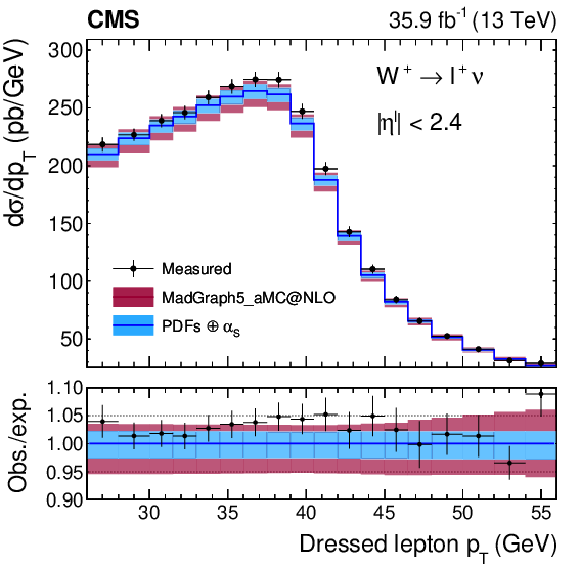
png pdf |
Figure A18-a:
Absolute cross sections as functions of ${{p_{\mathrm {T}}} ^{\ell}}$, integrated over ${{| \eta ^{\ell} |}}$ for ${\mathrm{W^{+}}}$ (left) and ${\mathrm{W^{-}}}$ (right) bosons. The colored bands represent the prediction from MadGraph5_aMC@NLO with the expected uncertainty from the quadrature sum of the PDF$\oplus {\alpha _S} $ variations (blue) and the ${\mu _\mathrm {F}}$ and ${\mu _\mathrm {R}}$ scales (bordeaux). |
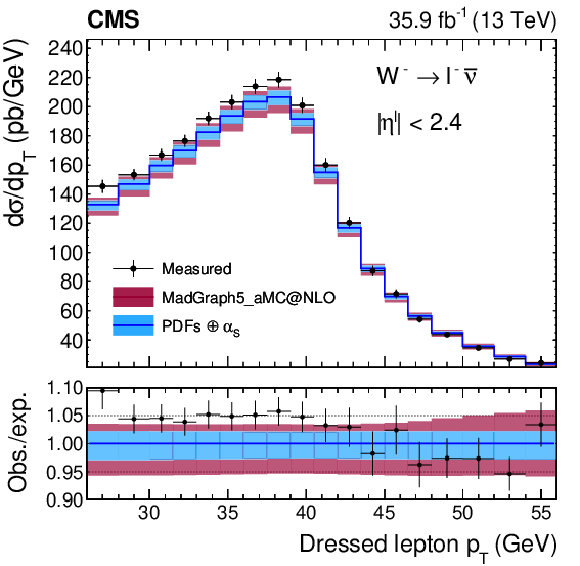
png pdf |
Figure A18-b:
Absolute cross sections as functions of ${{p_{\mathrm {T}}} ^{\ell}}$, integrated over ${{| \eta ^{\ell} |}}$ for ${\mathrm{W^{+}}}$ (left) and ${\mathrm{W^{-}}}$ (right) bosons. The colored bands represent the prediction from MadGraph5_aMC@NLO with the expected uncertainty from the quadrature sum of the PDF$\oplus {\alpha _S} $ variations (blue) and the ${\mu _\mathrm {F}}$ and ${\mu _\mathrm {R}}$ scales (bordeaux). |

png pdf |
Figure A19:
Normalized cross sections as functions of ${{p_{\mathrm {T}}} ^{\ell}}$, integrated over ${{| \eta ^{\ell} |}}$ for ${\mathrm{W^{+}}}$ (left) and ${\mathrm{W^{-}}}$ (right) bosons. The colored bands represent the prediction from MadGraph5_aMC@NLO with the expected uncertainty from the quadrature sum of the PDF$\oplus {\alpha _S} $ variations (blue) and the ${\mu _\mathrm {F}}$ and ${\mu _\mathrm {R}}$ scales (bordeaux). |

png pdf |
Figure A19-a:
Normalized cross sections as functions of ${{p_{\mathrm {T}}} ^{\ell}}$, integrated over ${{| \eta ^{\ell} |}}$ for ${\mathrm{W^{+}}}$ (left) and ${\mathrm{W^{-}}}$ (right) bosons. The colored bands represent the prediction from MadGraph5_aMC@NLO with the expected uncertainty from the quadrature sum of the PDF$\oplus {\alpha _S} $ variations (blue) and the ${\mu _\mathrm {F}}$ and ${\mu _\mathrm {R}}$ scales (bordeaux). |

png pdf |
Figure A19-b:
Normalized cross sections as functions of ${{p_{\mathrm {T}}} ^{\ell}}$, integrated over ${{| \eta ^{\ell} |}}$ for ${\mathrm{W^{+}}}$ (left) and ${\mathrm{W^{-}}}$ (right) bosons. The colored bands represent the prediction from MadGraph5_aMC@NLO with the expected uncertainty from the quadrature sum of the PDF$\oplus {\alpha _S} $ variations (blue) and the ${\mu _\mathrm {F}}$ and ${\mu _\mathrm {R}}$ scales (bordeaux). |

png pdf |
Figure A20:
W charge asymmetry as functions of ${{p_{\mathrm {T}}} ^{\ell}}$, integrated over ${{| \eta ^{\ell} |}}$. The colored bands represent the prediction from MadGraph5_aMC@NLO with the expected uncertainty from the quadrature sum of the PDF$\oplus {\alpha _S} $ variations (blue) and the ${\mu _\mathrm {F}}$ and ${\mu _\mathrm {R}}$ scales (bordeaux). |
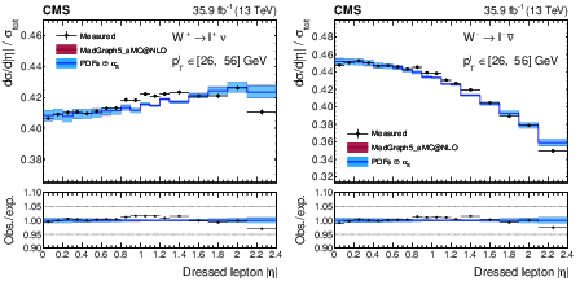
png pdf |
Figure A21:
Normalized cross sections as functions of ${{| \eta ^{\ell} |}}$, integrated over ${{p_{\mathrm {T}}} ^{\ell}}$ for ${\mathrm{W^{+}}}$ (left) and ${\mathrm{W^{-}}}$ (right) bosons. The colored bands represent the prediction from MadGraph5_aMC@NLO with the expected uncertainty from the quadrature sum of the PDF$\oplus {\alpha _S} $ variations (blue) and the ${\mu _\mathrm {F}}$ and ${\mu _\mathrm {R}}$ scales (bordeaux). The uncertainty band is almost entirely dominated by the PDF$\oplus {\alpha _S} $ variations, while the missing higher order QCD uncertainties almost perfectly cancel and are therefore invisible. |

png pdf |
Figure A21-a:
Normalized cross sections as functions of ${{| \eta ^{\ell} |}}$, integrated over ${{p_{\mathrm {T}}} ^{\ell}}$ for ${\mathrm{W^{+}}}$ (left) and ${\mathrm{W^{-}}}$ (right) bosons. The colored bands represent the prediction from MadGraph5_aMC@NLO with the expected uncertainty from the quadrature sum of the PDF$\oplus {\alpha _S} $ variations (blue) and the ${\mu _\mathrm {F}}$ and ${\mu _\mathrm {R}}$ scales (bordeaux). The uncertainty band is almost entirely dominated by the PDF$\oplus {\alpha _S} $ variations, while the missing higher order QCD uncertainties almost perfectly cancel and are therefore invisible. |

png pdf |
Figure A21-b:
Normalized cross sections as functions of ${{| \eta ^{\ell} |}}$, integrated over ${{p_{\mathrm {T}}} ^{\ell}}$ for ${\mathrm{W^{+}}}$ (left) and ${\mathrm{W^{-}}}$ (right) bosons. The colored bands represent the prediction from MadGraph5_aMC@NLO with the expected uncertainty from the quadrature sum of the PDF$\oplus {\alpha _S} $ variations (blue) and the ${\mu _\mathrm {F}}$ and ${\mu _\mathrm {R}}$ scales (bordeaux). The uncertainty band is almost entirely dominated by the PDF$\oplus {\alpha _S} $ variations, while the missing higher order QCD uncertainties almost perfectly cancel and are therefore invisible. |
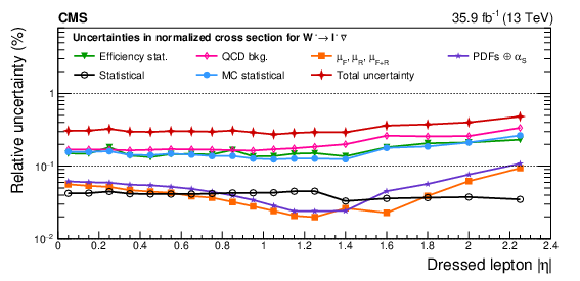
png pdf |
Figure A22:
Remaining impacts of the nuisance groups on the normalized cross sections as functions of ${{| \eta ^{\ell} |}}$, integrated in ${{p_{\mathrm {T}}} ^{\ell}}$, for ${\mathrm{W^{-}}}$ bosons in the double-differential cross section fit. The groups of uncertainties subleading to the ones shown are suppressed for simplicity. |
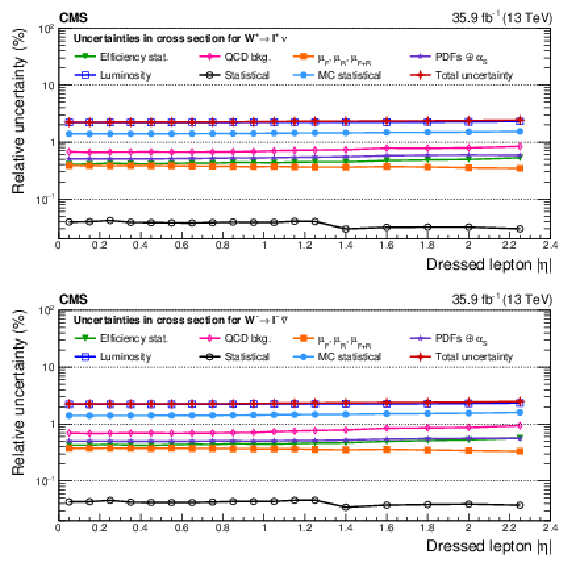
png pdf |
Figure A23:
Remaining impacts of the nuisance groups on the absolute cross sections as functions of ${{| \eta ^{\ell} |}}$, integrated in ${{p_{\mathrm {T}}} ^{\ell}}$, for ${\mathrm{W^{+}}}$ (upper) and ${\mathrm{W^{-}}}$ (lower) bosons in the double-differential cross section fit. The groups of uncertainties subleading to the ones shown are suppressed for simplicity. |
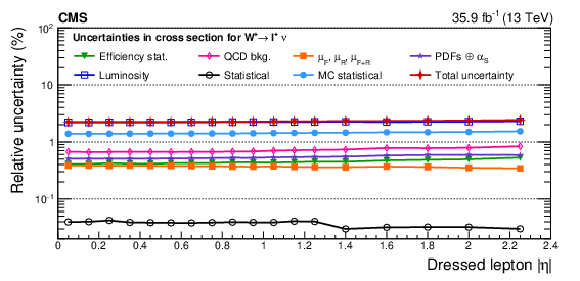
png pdf |
Figure A23-a:
Remaining impacts of the nuisance groups on the absolute cross sections as functions of ${{| \eta ^{\ell} |}}$, integrated in ${{p_{\mathrm {T}}} ^{\ell}}$, for ${\mathrm{W^{+}}}$ (upper) and ${\mathrm{W^{-}}}$ (lower) bosons in the double-differential cross section fit. The groups of uncertainties subleading to the ones shown are suppressed for simplicity. |
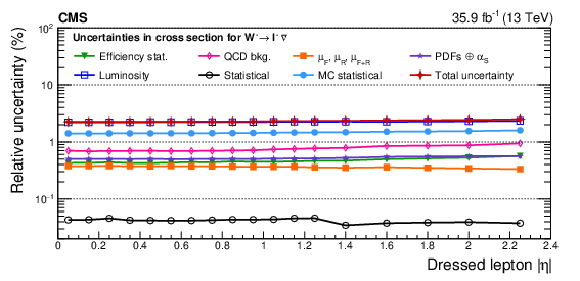
png pdf |
Figure A23-b:
Remaining impacts of the nuisance groups on the absolute cross sections as functions of ${{| \eta ^{\ell} |}}$, integrated in ${{p_{\mathrm {T}}} ^{\ell}}$, for ${\mathrm{W^{+}}}$ (upper) and ${\mathrm{W^{-}}}$ (lower) bosons in the double-differential cross section fit. The groups of uncertainties subleading to the ones shown are suppressed for simplicity. |
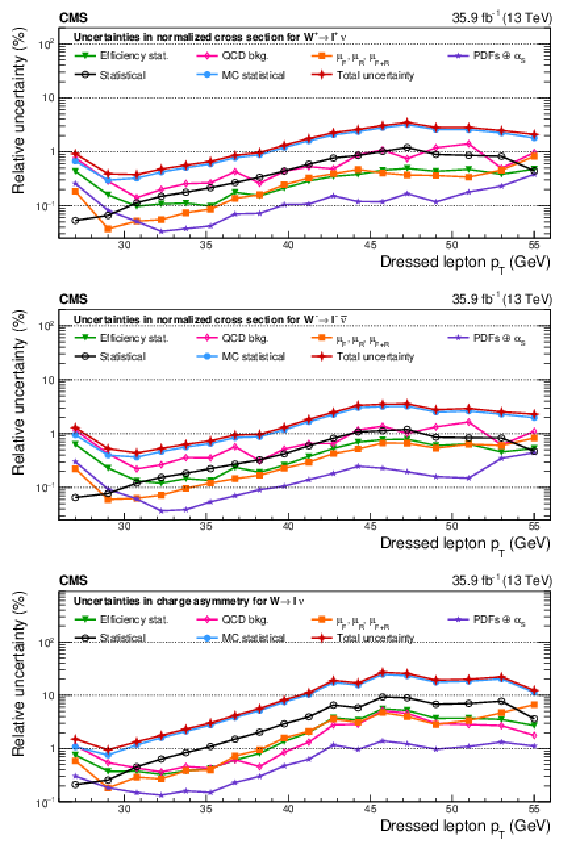
png pdf |
Figure A24:
Remaining impacts of the nuisance groups on the normalized cross sections as functions of ${{p_{\mathrm {T}}} ^{\ell}}$, integrated over ${{| \eta ^{\ell} |}}$, for ${\mathrm{W^{+}}}$ (upper), ${\mathrm{W^{-}}}$ (middle) bosons, and the resulting charge asymmetry (lower) in the double-differential cross section fit. The groups of uncertainties subleading to the ones shown are suppressed for simplicity. |

png pdf |
Figure A24-a:
Remaining impacts of the nuisance groups on the normalized cross sections as functions of ${{p_{\mathrm {T}}} ^{\ell}}$, integrated over ${{| \eta ^{\ell} |}}$, for ${\mathrm{W^{+}}}$ (upper), ${\mathrm{W^{-}}}$ (middle) bosons, and the resulting charge asymmetry (lower) in the double-differential cross section fit. The groups of uncertainties subleading to the ones shown are suppressed for simplicity. |

png pdf |
Figure A24-b:
Remaining impacts of the nuisance groups on the normalized cross sections as functions of ${{p_{\mathrm {T}}} ^{\ell}}$, integrated over ${{| \eta ^{\ell} |}}$, for ${\mathrm{W^{+}}}$ (upper), ${\mathrm{W^{-}}}$ (middle) bosons, and the resulting charge asymmetry (lower) in the double-differential cross section fit. The groups of uncertainties subleading to the ones shown are suppressed for simplicity. |
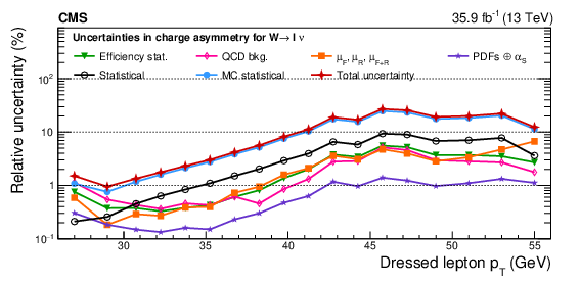
png pdf |
Figure A24-c:
Remaining impacts of the nuisance groups on the normalized cross sections as functions of ${{p_{\mathrm {T}}} ^{\ell}}$, integrated over ${{| \eta ^{\ell} |}}$, for ${\mathrm{W^{+}}}$ (upper), ${\mathrm{W^{-}}}$ (middle) bosons, and the resulting charge asymmetry (lower) in the double-differential cross section fit. The groups of uncertainties subleading to the ones shown are suppressed for simplicity. |

png pdf |
Figure A25:
Remaining impacts of the nuisance groups on the absolute cross sections as functions of ${{p_{\mathrm {T}}} ^{\ell}}$, integrated over ${{| \eta ^{\ell} |}}$, for ${\mathrm{W^{+}}}$ (upper) and ${\mathrm{W^{-}}}$ (lower) bosons in the double-differential cross section fit. The groups of uncertainties subleading to the ones shown are suppressed for simplicity. |
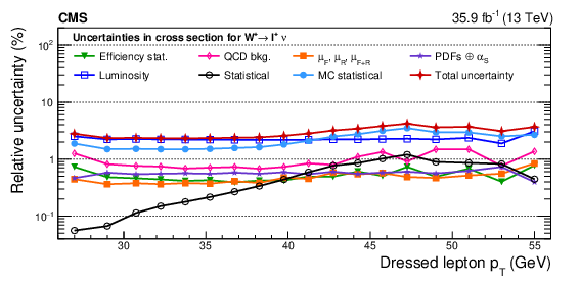
png pdf |
Figure A25-a:
Remaining impacts of the nuisance groups on the absolute cross sections as functions of ${{p_{\mathrm {T}}} ^{\ell}}$, integrated over ${{| \eta ^{\ell} |}}$, for ${\mathrm{W^{+}}}$ (upper) and ${\mathrm{W^{-}}}$ (lower) bosons in the double-differential cross section fit. The groups of uncertainties subleading to the ones shown are suppressed for simplicity. |

png pdf |
Figure A25-b:
Remaining impacts of the nuisance groups on the absolute cross sections as functions of ${{p_{\mathrm {T}}} ^{\ell}}$, integrated over ${{| \eta ^{\ell} |}}$, for ${\mathrm{W^{+}}}$ (upper) and ${\mathrm{W^{-}}}$ (lower) bosons in the double-differential cross section fit. The groups of uncertainties subleading to the ones shown are suppressed for simplicity. |
| Tables | |
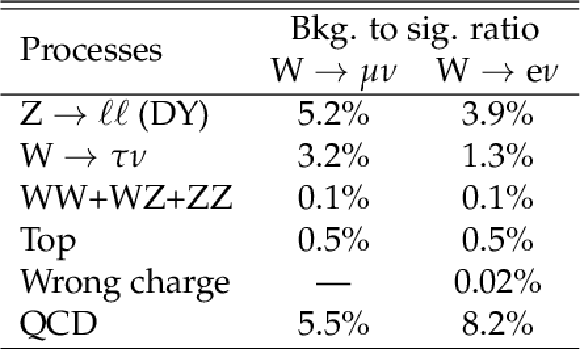
png pdf |
Table 1:
Estimated background-to-signal ratios in the $\mathrm{W} \to \mu \nu $ and $\mathrm{W} \to \mathrm{e} \nu $ channels. The DY simulation includes $\ell =$ e, $\mu$, $\tau $. |
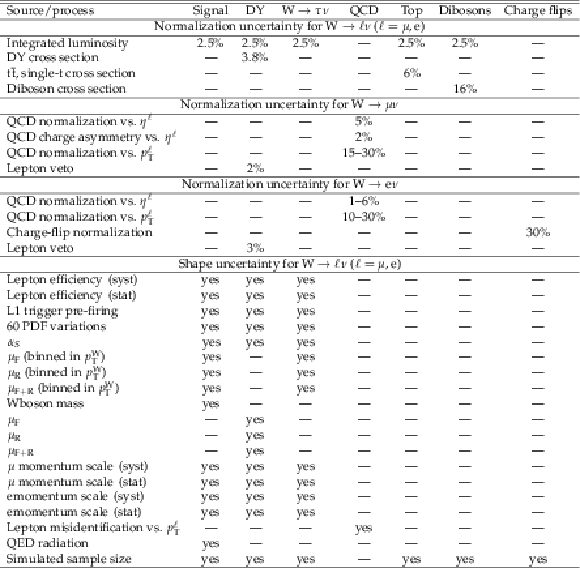
png pdf |
Table 2:
Systematic uncertainties for each source and process. Quoted numbers correspond to the size of log-normal nuisance parameters applied in the fit, while a "yes'' in a given cell corresponds to the given systematic uncertainty being applied as a shape variation over the full 2D template space. |
| Summary |
|
The differential W boson cross sections as functions of the W boson rapidity, $|{y_{\mathrm{W}}}| $, and for the two charges separately, ${\mathrm{W^{+}}} \to \ell^+\nu$ and ${\mathrm{W^{-}}} \to \ell^-\bar{\nu}$, are measured in the W boson helicity states. Double-differential cross sections of the W boson are measured as a function of the charged-lepton transverse momentum ${p_{\mathrm{T}}}^{\ell}$ and absolute pseudorapidity $|{\eta^{\ell}}|$. For both ${\mathrm{W^{+}}}$ and ${\mathrm{W^{-}}}$ bosons, the differential charge asymmetry is also extracted. The measurement is based on data taken in proton-proton collisions at the LHC at a center-of-mass energy of $\sqrt{s} = $ 13 TeV, corresponding to an integrated luminosity of 35.9 fb$^{-1}$. Differential cross sections are presented, both absolute and normalized to the total production cross section within a given acceptance. For the helicity measurement, the range $|{y_{\mathrm{W}}}| < $ 2.5 is presented, whereas for the double-differential cross section the range $|{\eta^{\ell}}| < $ 2.4 and 26 $ < {p_{\mathrm{T}}}^{\ell} < $ 56 GeV is used. The measurement is performed using both the muon and electron channels, combined together considering all sources of correlated and uncorrelated uncertainties. The precision in the measurement as a function of $|{y_{\mathrm{W}}}|$, using a combination of the two channels, is about 2% in central $|{y_{\mathrm{W}}}|$ bins, and 5 to 20%, depending on the charge-polarization combination, in the outermost acceptance bins. The precision of the double-differential cross section, relative to the total, is about 1% in the central part of the detector, $|{\eta^{\ell}}| < $ 1, and better than 2.5% up to $|{\eta^{\ell}}| < $ 2 for each of the two W boson charges. Charge asymmetries are also measured, differentially in $|{y_{\mathrm{W}}}|$ and polarization, as well as in ${p_{\mathrm{T}}}^{\ell}$ and $|{\eta^{\ell}}|$. The uncertainties in these asymmetries range from 0.1% in high-acceptance bins to roughly 2.5% in regions of phase space with lower detector acceptance. Furthermore, fiducial cross sections are presented by integrating the two-dimensional differential cross sections over the full acceptance of the analysis. The measurement of the W boson polarized cross sections as functions of $|{y_{\mathrm{W}}}|$ is used to constrain the parameters related to parton distribution functions in a simultaneous fit of the two channels and the two W boson charges. The constraints are derived at the detector level on 60 uncorrelated eigenvalues of the NNPDF3.0 set of PDFs within the MadGraph5+MCatNLO event generator, and show a total constraint down to $\simeq$70% of the pre-fit uncertainties for certain variations of the PDF nuisance parameters. |
| Additional Figures | |

png pdf |
Additional Figure 1:
Distributions of ${\eta ^{\ell}}$ and ${{p_{\mathrm {T}}} ^{\ell}}$ of the reconstructed muon in W boson decays, split into W boson charge and polarization (left, longitudinal, right). For a given charge and helicity state, the particular shape of each distribution is determined by the underlying W rapidity distribution, which in turn depends on the proton PDFs. These distributions are obtained from simulated $\mathrm{W} \rightarrow \mu \nu $+jets events at $\sqrt {s} = $ 13 TeV using MadGraph5_aMC@NLO. Event yields are normalized to an integrated luminosity of 35.9 fb$^{-1}$. No event selection is applied, except for the requirement that a muon is identified and reconstructed within the CMS detector and the plot boundaries in ${{p_{\mathrm {T}}} ^{\ell}}$ from 25 to 50 GeV and $| \eta ^{\ell} | < $ 2.4. |

png pdf |
Additional Figure 1-a:
Distribution of ${\eta ^{\ell}}$ and ${{p_{\mathrm {T}}} ^{\ell}}$ of the reconstructed muon in W boson decays, for positive charge and left polarization. For a given charge and helicity state, the particular shape of each distribution is determined by the underlying W rapidity distribution, which in turn depends on the proton PDFs. This distribution is obtained from simulated $\mathrm{W} \rightarrow \mu \nu $+jets events at $\sqrt {s} = $ 13 TeV using MadGraph5_aMC@NLO. Event yields are normalized to an integrated luminosity of 35.9 fb$^{-1}$. No event selection is applied, except for the requirement that a muon is identified and reconstructed within the CMS detector and the plot boundaries in ${{p_{\mathrm {T}}} ^{\ell}}$ from 25 to 50 GeV and $| \eta ^{\ell} | < $ 2.4. |

png pdf |
Additional Figure 1-b:
Distribution of ${\eta ^{\ell}}$ and ${{p_{\mathrm {T}}} ^{\ell}}$ of the reconstructed muon in W boson decays, for positive charge and longitudinal polarization. For a given charge and helicity state, the particular shape of each distribution is determined by the underlying W rapidity distribution, which in turn depends on the proton PDFs. This distribution is obtained from simulated $\mathrm{W} \rightarrow \mu \nu $+jets events at $\sqrt {s} = $ 13 TeV using MadGraph5_aMC@NLO. Event yields are normalized to an integrated luminosity of 35.9 fb$^{-1}$. No event selection is applied, except for the requirement that a muon is identified and reconstructed within the CMS detector and the plot boundaries in ${{p_{\mathrm {T}}} ^{\ell}}$ from 25 to 50 GeV and $| \eta ^{\ell} | < $ 2.4. |

png pdf |
Additional Figure 1-c:
Distribution of ${\eta ^{\ell}}$ and ${{p_{\mathrm {T}}} ^{\ell}}$ of the reconstructed muon in W boson decays, for positive charge and right polarization. For a given charge and helicity state, the particular shape of each distribution is determined by the underlying W rapidity distribution, which in turn depends on the proton PDFs. This distribution is obtained from simulated $\mathrm{W} \rightarrow \mu \nu $+jets events at $\sqrt {s} = $ 13 TeV using MadGraph5_aMC@NLO. Event yields are normalized to an integrated luminosity of 35.9 fb$^{-1}$. No event selection is applied, except for the requirement that a muon is identified and reconstructed within the CMS detector and the plot boundaries in ${{p_{\mathrm {T}}} ^{\ell}}$ from 25 to 50 GeV and $| \eta ^{\ell} | < $ 2.4. |
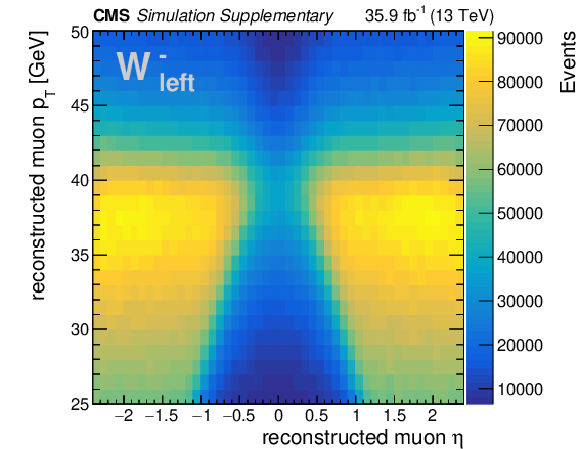
png pdf |
Additional Figure 1-d:
Distribution of ${\eta ^{\ell}}$ and ${{p_{\mathrm {T}}} ^{\ell}}$ of the reconstructed muon in W boson decays, for negative charge and left polarization. For a given charge and helicity state, the particular shape of each distribution is determined by the underlying W rapidity distribution, which in turn depends on the proton PDFs. This distribution is obtained from simulated $\mathrm{W} \rightarrow \mu \nu $+jets events at $\sqrt {s} = $ 13 TeV using MadGraph5_aMC@NLO. Event yields are normalized to an integrated luminosity of 35.9 fb$^{-1}$. No event selection is applied, except for the requirement that a muon is identified and reconstructed within the CMS detector and the plot boundaries in ${{p_{\mathrm {T}}} ^{\ell}}$ from 25 to 50 GeV and $| \eta ^{\ell} | < $ 2.4. |

png pdf |
Additional Figure 1-e:
Distribution of ${\eta ^{\ell}}$ and ${{p_{\mathrm {T}}} ^{\ell}}$ of the reconstructed muon in W boson decays, for negative charge and longitudinal polarization. For a given charge and helicity state, the particular shape of each distribution is determined by the underlying W rapidity distribution, which in turn depends on the proton PDFs. This distribution is obtained from simulated $\mathrm{W} \rightarrow \mu \nu $+jets events at $\sqrt {s} = $ 13 TeV using MadGraph5_aMC@NLO. Event yields are normalized to an integrated luminosity of 35.9 fb$^{-1}$. No event selection is applied, except for the requirement that a muon is identified and reconstructed within the CMS detector and the plot boundaries in ${{p_{\mathrm {T}}} ^{\ell}}$ from 25 to 50 GeV and $| \eta ^{\ell} | < $ 2.4. |

png pdf |
Additional Figure 1-f:
Distribution of ${\eta ^{\ell}}$ and ${{p_{\mathrm {T}}} ^{\ell}}$ of the reconstructed muon in W boson decays, for negative charge and right polarization. For a given charge and helicity state, the particular shape of each distribution is determined by the underlying W rapidity distribution, which in turn depends on the proton PDFs. This distribution is obtained from simulated $\mathrm{W} \rightarrow \mu \nu $+jets events at $\sqrt {s} = $ 13 TeV using MadGraph5_aMC@NLO. Event yields are normalized to an integrated luminosity of 35.9 fb$^{-1}$. No event selection is applied, except for the requirement that a muon is identified and reconstructed within the CMS detector and the plot boundaries in ${{p_{\mathrm {T}}} ^{\ell}}$ from 25 to 50 GeV and $| \eta ^{\ell} | < $ 2.4. |
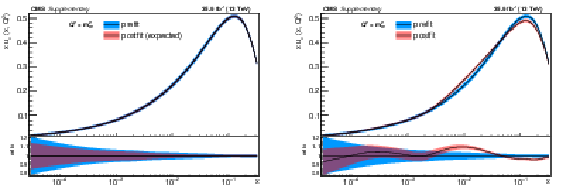
png pdf |
Additional Figure 2:
The post-fit nuisance parameter values and covariance matrix for the PDF and $\alpha _S$ uncertainties from the fixed-parameter-of-interest fit described in Section 8.2 are propagated to the corresponding change in central value and uncertainty with respect to the input NNPDF3.0 NLO PDF set as a function of x for fixed $Q^2=M_\mathrm {W}^2$. The profiling procedure employed here has the caveat that the results cannot be interpreted as a rigorous PDF determination in case the results are far from the input PDF, and that the measurement under consideration tends to have a larger weight than if it were included in a global PDF determination. Nevertheless the profiling procedure is useful to assess the sensitivity of the different parton distributions to this measurement, and its compatibility with the predictions of the input PDF set. Particular to this result is the fact that constraints are derived only at NLO + parton shower accuracy in QCD, and that there are possible limitations of the PDF set used with respect to newer sets. The presence of oscillatory behaviour in the valence quark distributions is in part related to anti-correlations between different x values arising from the statistical uncertainties in the underlying measurement. |
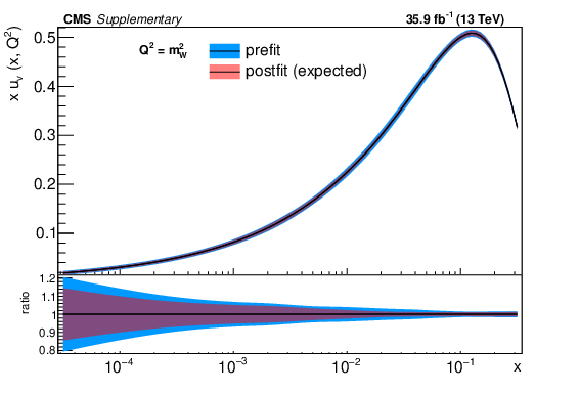
png pdf |
Additional Figure 2-a:
The post-fit nuisance parameter values and covariance matrix for the PDF and $\alpha _S$ uncertainties from the fixed-parameter-of-interest fit described in Section 8.2 are propagated to the corresponding change in central value and uncertainty with respect to the input NNPDF3.0 NLO PDF set as a function of x for fixed $Q^2=M_\mathrm {W}^2$. The profiling procedure employed here has the caveat that the results cannot be interpreted as a rigorous PDF determination in case the results are far from the input PDF, and that the measurement under consideration tends to have a larger weight than if it were included in a global PDF determination. Nevertheless the profiling procedure is useful to assess the sensitivity of the different parton distributions to this measurement, and its compatibility with the predictions of the input PDF set. Particular to this result is the fact that constraints are derived only at NLO + parton shower accuracy in QCD, and that there are possible limitations of the PDF set used with respect to newer sets. The presence of oscillatory behaviour in the valence quark distributions is in part related to anti-correlations between different x values arising from the statistical uncertainties in the underlying measurement. |
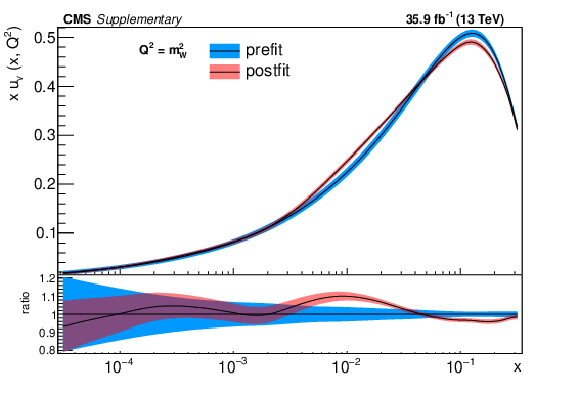
png pdf |
Additional Figure 2-b:
The post-fit nuisance parameter values and covariance matrix for the PDF and $\alpha _S$ uncertainties from the fixed-parameter-of-interest fit described in Section 8.2 are propagated to the corresponding change in central value and uncertainty with respect to the input NNPDF3.0 NLO PDF set as a function of x for fixed $Q^2=M_\mathrm {W}^2$. The profiling procedure employed here has the caveat that the results cannot be interpreted as a rigorous PDF determination in case the results are far from the input PDF, and that the measurement under consideration tends to have a larger weight than if it were included in a global PDF determination. Nevertheless the profiling procedure is useful to assess the sensitivity of the different parton distributions to this measurement, and its compatibility with the predictions of the input PDF set. Particular to this result is the fact that constraints are derived only at NLO + parton shower accuracy in QCD, and that there are possible limitations of the PDF set used with respect to newer sets. The presence of oscillatory behaviour in the valence quark distributions is in part related to anti-correlations between different x values arising from the statistical uncertainties in the underlying measurement. |
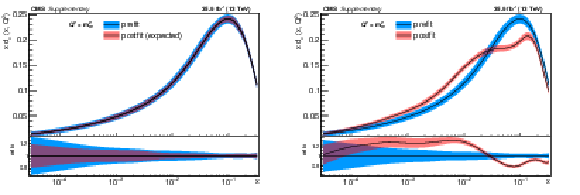
png pdf |
Additional Figure 3:
The post-fit nuisance parameter values and covariance matrix for the PDF and $\alpha _S$ uncertainties from the fixed-parameter-of-interest fit described in Section 8.2 are propagated to the corresponding change in central value and uncertainty with respect to the input NNPDF3.0 NLO PDF set as a function of x for fixed $Q^2=M_\mathrm {W}^2$. The profiling procedure employed here has the caveat that the results cannot be interpreted as a rigorous PDF determination in case the results are far from the input PDF, and that the measurement under consideration tends to have a larger weight than if it were included in a global PDF determination. Nevertheless the profiling procedure is useful to assess the sensitivity of the different parton distributions to this measurement, and its compatibility with the predictions of the input PDF set. Particular to this result is the fact that constraints are derived only at NLO + parton shower accuracy in QCD, and that there are possible limitations of the PDF set used with respect to newer sets. The presence of oscillatory behaviour in the valence quark distributions is in part related to anti-correlations between different x values arising from the statistical uncertainties in the underlying measurement. |

png pdf |
Additional Figure 3-a:
The post-fit nuisance parameter values and covariance matrix for the PDF and $\alpha _S$ uncertainties from the fixed-parameter-of-interest fit described in Section 8.2 are propagated to the corresponding change in central value and uncertainty with respect to the input NNPDF3.0 NLO PDF set as a function of x for fixed $Q^2=M_\mathrm {W}^2$. The profiling procedure employed here has the caveat that the results cannot be interpreted as a rigorous PDF determination in case the results are far from the input PDF, and that the measurement under consideration tends to have a larger weight than if it were included in a global PDF determination. Nevertheless the profiling procedure is useful to assess the sensitivity of the different parton distributions to this measurement, and its compatibility with the predictions of the input PDF set. Particular to this result is the fact that constraints are derived only at NLO + parton shower accuracy in QCD, and that there are possible limitations of the PDF set used with respect to newer sets. The presence of oscillatory behaviour in the valence quark distributions is in part related to anti-correlations between different x values arising from the statistical uncertainties in the underlying measurement. |

png pdf |
Additional Figure 3-b:
The post-fit nuisance parameter values and covariance matrix for the PDF and $\alpha _S$ uncertainties from the fixed-parameter-of-interest fit described in Section 8.2 are propagated to the corresponding change in central value and uncertainty with respect to the input NNPDF3.0 NLO PDF set as a function of x for fixed $Q^2=M_\mathrm {W}^2$. The profiling procedure employed here has the caveat that the results cannot be interpreted as a rigorous PDF determination in case the results are far from the input PDF, and that the measurement under consideration tends to have a larger weight than if it were included in a global PDF determination. Nevertheless the profiling procedure is useful to assess the sensitivity of the different parton distributions to this measurement, and its compatibility with the predictions of the input PDF set. Particular to this result is the fact that constraints are derived only at NLO + parton shower accuracy in QCD, and that there are possible limitations of the PDF set used with respect to newer sets. The presence of oscillatory behaviour in the valence quark distributions is in part related to anti-correlations between different x values arising from the statistical uncertainties in the underlying measurement. |

png pdf |
Additional Figure 4:
The post-fit nuisance parameter values and covariance matrix for the PDF and $\alpha _S$ uncertainties from the fixed-parameter-of-interest fit described in Section 8.2 are propagated to the corresponding change in central value and uncertainty with respect to the input NNPDF3.0 NLO PDF set as a function of x for fixed $Q^2=M_\mathrm {W}^2$. The profiling procedure employed here has the caveat that the results cannot be interpreted as a rigorous PDF determination in case the results are far from the input PDF, and that the measurement under consideration tends to have a larger weight than if it were included in a global PDF determination. Nevertheless the profiling procedure is useful to assess the sensitivity of the different parton distributions to this measurement, and its compatibility with the predictions of the input PDF set. Particular to this result is the fact that constraints are derived only at NLO + parton shower accuracy in QCD, and that there are possible limitations of the PDF set used with respect to newer sets. The presence of oscillatory behaviour in the valence quark distributions is in part related to anti-correlations between different x values arising from the statistical uncertainties in the underlying measurement. |
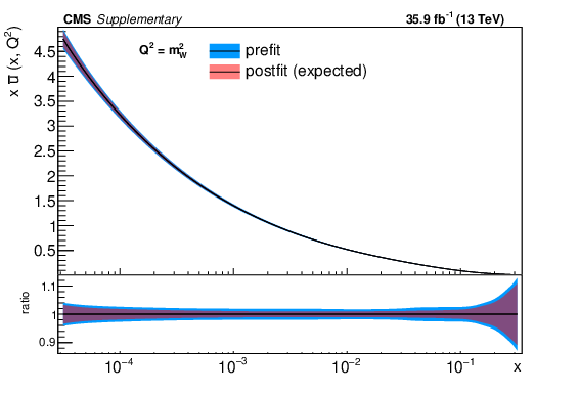
png pdf |
Additional Figure 4-a:
The post-fit nuisance parameter values and covariance matrix for the PDF and $\alpha _S$ uncertainties from the fixed-parameter-of-interest fit described in Section 8.2 are propagated to the corresponding change in central value and uncertainty with respect to the input NNPDF3.0 NLO PDF set as a function of x for fixed $Q^2=M_\mathrm {W}^2$. The profiling procedure employed here has the caveat that the results cannot be interpreted as a rigorous PDF determination in case the results are far from the input PDF, and that the measurement under consideration tends to have a larger weight than if it were included in a global PDF determination. Nevertheless the profiling procedure is useful to assess the sensitivity of the different parton distributions to this measurement, and its compatibility with the predictions of the input PDF set. Particular to this result is the fact that constraints are derived only at NLO + parton shower accuracy in QCD, and that there are possible limitations of the PDF set used with respect to newer sets. The presence of oscillatory behaviour in the valence quark distributions is in part related to anti-correlations between different x values arising from the statistical uncertainties in the underlying measurement. |
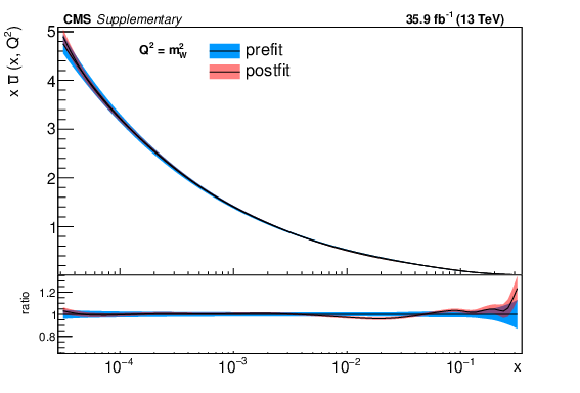
png pdf |
Additional Figure 4-b:
The post-fit nuisance parameter values and covariance matrix for the PDF and $\alpha _S$ uncertainties from the fixed-parameter-of-interest fit described in Section 8.2 are propagated to the corresponding change in central value and uncertainty with respect to the input NNPDF3.0 NLO PDF set as a function of x for fixed $Q^2=M_\mathrm {W}^2$. The profiling procedure employed here has the caveat that the results cannot be interpreted as a rigorous PDF determination in case the results are far from the input PDF, and that the measurement under consideration tends to have a larger weight than if it were included in a global PDF determination. Nevertheless the profiling procedure is useful to assess the sensitivity of the different parton distributions to this measurement, and its compatibility with the predictions of the input PDF set. Particular to this result is the fact that constraints are derived only at NLO + parton shower accuracy in QCD, and that there are possible limitations of the PDF set used with respect to newer sets. The presence of oscillatory behaviour in the valence quark distributions is in part related to anti-correlations between different x values arising from the statistical uncertainties in the underlying measurement. |

png pdf |
Additional Figure 5:
The post-fit nuisance parameter values and covariance matrix for the PDF and $\alpha _S$ uncertainties from the fixed-parameter-of-interest fit described in Section 8.2 are propagated to the corresponding change in central value and uncertainty with respect to the input NNPDF3.0 NLO PDF set as a function of x for fixed $Q^2=M_\mathrm {W}^2$. The profiling procedure employed here has the caveat that the results cannot be interpreted as a rigorous PDF determination in case the results are far from the input PDF, and that the measurement under consideration tends to have a larger weight than if it were included in a global PDF determination. Nevertheless the profiling procedure is useful to assess the sensitivity of the different parton distributions to this measurement, and its compatibility with the predictions of the input PDF set. Particular to this result is the fact that constraints are derived only at NLO + parton shower accuracy in QCD, and that there are possible limitations of the PDF set used with respect to newer sets. The presence of oscillatory behaviour in the valence quark distributions is in part related to anti-correlations between different x values arising from the statistical uncertainties in the underlying measurement. |

png pdf |
Additional Figure 5-a:
The post-fit nuisance parameter values and covariance matrix for the PDF and $\alpha _S$ uncertainties from the fixed-parameter-of-interest fit described in Section 8.2 are propagated to the corresponding change in central value and uncertainty with respect to the input NNPDF3.0 NLO PDF set as a function of x for fixed $Q^2=M_\mathrm {W}^2$. The profiling procedure employed here has the caveat that the results cannot be interpreted as a rigorous PDF determination in case the results are far from the input PDF, and that the measurement under consideration tends to have a larger weight than if it were included in a global PDF determination. Nevertheless the profiling procedure is useful to assess the sensitivity of the different parton distributions to this measurement, and its compatibility with the predictions of the input PDF set. Particular to this result is the fact that constraints are derived only at NLO + parton shower accuracy in QCD, and that there are possible limitations of the PDF set used with respect to newer sets. The presence of oscillatory behaviour in the valence quark distributions is in part related to anti-correlations between different x values arising from the statistical uncertainties in the underlying measurement. |
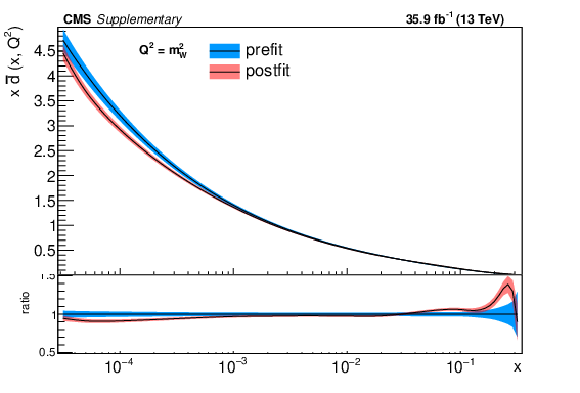
png pdf |
Additional Figure 5-b:
The post-fit nuisance parameter values and covariance matrix for the PDF and $\alpha _S$ uncertainties from the fixed-parameter-of-interest fit described in Section 8.2 are propagated to the corresponding change in central value and uncertainty with respect to the input NNPDF3.0 NLO PDF set as a function of x for fixed $Q^2=M_\mathrm {W}^2$. The profiling procedure employed here has the caveat that the results cannot be interpreted as a rigorous PDF determination in case the results are far from the input PDF, and that the measurement under consideration tends to have a larger weight than if it were included in a global PDF determination. Nevertheless the profiling procedure is useful to assess the sensitivity of the different parton distributions to this measurement, and its compatibility with the predictions of the input PDF set. Particular to this result is the fact that constraints are derived only at NLO + parton shower accuracy in QCD, and that there are possible limitations of the PDF set used with respect to newer sets. The presence of oscillatory behaviour in the valence quark distributions is in part related to anti-correlations between different x values arising from the statistical uncertainties in the underlying measurement. |

png pdf |
Additional Figure 6:
The post-fit nuisance parameter values and covariance matrix for the PDF and $\alpha _S$ uncertainties from the fixed-parameter-of-interest fit described in Section 8.2 are propagated to the corresponding change in central value and uncertainty with respect to the input NNPDF3.0 NLO PDF set as a function of x for fixed $Q^2=M_\mathrm {W}^2$. The profiling procedure employed here has the caveat that the results cannot be interpreted as a rigorous PDF determination in case the results are far from the input PDF, and that the measurement under consideration tends to have a larger weight than if it were included in a global PDF determination. Nevertheless the profiling procedure is useful to assess the sensitivity of the different parton distributions to this measurement, and its compatibility with the predictions of the input PDF set. Particular to this result is the fact that constraints are derived only at NLO + parton shower accuracy in QCD, and that there are possible limitations of the PDF set used with respect to newer sets. The presence of oscillatory behaviour in the valence quark distributions is in part related to anti-correlations between different x values arising from the statistical uncertainties in the underlying measurement. |

png pdf |
Additional Figure 6-a:
The post-fit nuisance parameter values and covariance matrix for the PDF and $\alpha _S$ uncertainties from the fixed-parameter-of-interest fit described in Section 8.2 are propagated to the corresponding change in central value and uncertainty with respect to the input NNPDF3.0 NLO PDF set as a function of x for fixed $Q^2=M_\mathrm {W}^2$. The profiling procedure employed here has the caveat that the results cannot be interpreted as a rigorous PDF determination in case the results are far from the input PDF, and that the measurement under consideration tends to have a larger weight than if it were included in a global PDF determination. Nevertheless the profiling procedure is useful to assess the sensitivity of the different parton distributions to this measurement, and its compatibility with the predictions of the input PDF set. Particular to this result is the fact that constraints are derived only at NLO + parton shower accuracy in QCD, and that there are possible limitations of the PDF set used with respect to newer sets. The presence of oscillatory behaviour in the valence quark distributions is in part related to anti-correlations between different x values arising from the statistical uncertainties in the underlying measurement. |
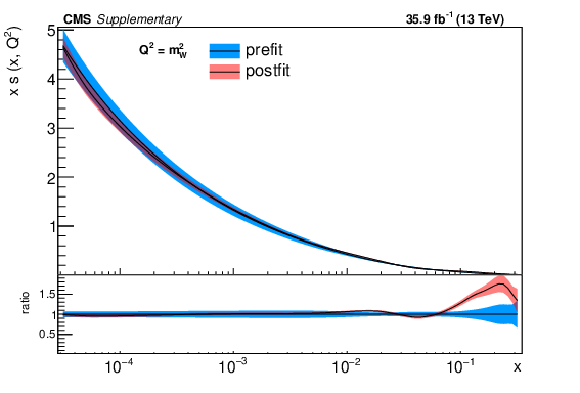
png pdf |
Additional Figure 6-b:
The post-fit nuisance parameter values and covariance matrix for the PDF and $\alpha _S$ uncertainties from the fixed-parameter-of-interest fit described in Section 8.2 are propagated to the corresponding change in central value and uncertainty with respect to the input NNPDF3.0 NLO PDF set as a function of x for fixed $Q^2=M_\mathrm {W}^2$. The profiling procedure employed here has the caveat that the results cannot be interpreted as a rigorous PDF determination in case the results are far from the input PDF, and that the measurement under consideration tends to have a larger weight than if it were included in a global PDF determination. Nevertheless the profiling procedure is useful to assess the sensitivity of the different parton distributions to this measurement, and its compatibility with the predictions of the input PDF set. Particular to this result is the fact that constraints are derived only at NLO + parton shower accuracy in QCD, and that there are possible limitations of the PDF set used with respect to newer sets. The presence of oscillatory behaviour in the valence quark distributions is in part related to anti-correlations between different x values arising from the statistical uncertainties in the underlying measurement. |
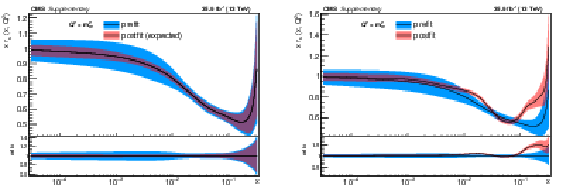
png pdf |
Additional Figure 7:
The post-fit nuisance parameter values and covariance matrix for the PDF and $\alpha _S$ uncertainties from the fixed-parameter-of-interest fit described in Section 8.2 are propagated to the corresponding change in central value and uncertainty with respect to the input NNPDF3.0 NLO PDF set as a function of x for fixed $Q^2=M_\mathrm {W}^2$. The profiling procedure employed here has the caveat that the results cannot be interpreted as a rigorous PDF determination in case the results are far from the input PDF, and that the measurement under consideration tends to have a larger weight than if it were included in a global PDF determination. Nevertheless the profiling procedure is useful to assess the sensitivity of the different parton distributions to this measurement, and its compatibility with the predictions of the input PDF set. Particular to this result is the fact that constraints are derived only at NLO + parton shower accuracy in QCD, and that there are possible limitations of the PDF set used with respect to newer sets. The presence of oscillatory behaviour in the valence quark distributions is in part related to anti-correlations between different x values arising from the statistical uncertainties in the underlying measurement. |
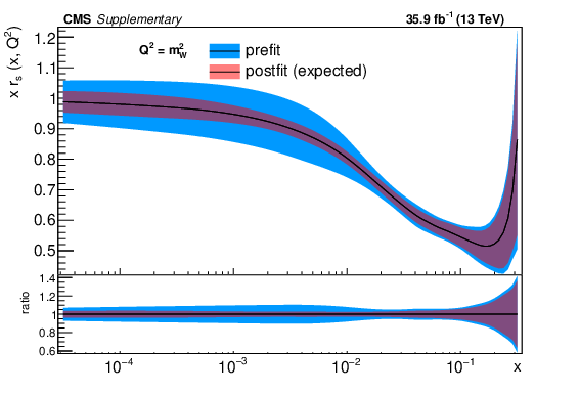
png pdf |
Additional Figure 7-a:
The post-fit nuisance parameter values and covariance matrix for the PDF and $\alpha _S$ uncertainties from the fixed-parameter-of-interest fit described in Section 8.2 are propagated to the corresponding change in central value and uncertainty with respect to the input NNPDF3.0 NLO PDF set as a function of x for fixed $Q^2=M_\mathrm {W}^2$. The profiling procedure employed here has the caveat that the results cannot be interpreted as a rigorous PDF determination in case the results are far from the input PDF, and that the measurement under consideration tends to have a larger weight than if it were included in a global PDF determination. Nevertheless the profiling procedure is useful to assess the sensitivity of the different parton distributions to this measurement, and its compatibility with the predictions of the input PDF set. Particular to this result is the fact that constraints are derived only at NLO + parton shower accuracy in QCD, and that there are possible limitations of the PDF set used with respect to newer sets. The presence of oscillatory behaviour in the valence quark distributions is in part related to anti-correlations between different x values arising from the statistical uncertainties in the underlying measurement. |

png pdf |
Additional Figure 7-b:
The post-fit nuisance parameter values and covariance matrix for the PDF and $\alpha _S$ uncertainties from the fixed-parameter-of-interest fit described in Section 8.2 are propagated to the corresponding change in central value and uncertainty with respect to the input NNPDF3.0 NLO PDF set as a function of x for fixed $Q^2=M_\mathrm {W}^2$. The profiling procedure employed here has the caveat that the results cannot be interpreted as a rigorous PDF determination in case the results are far from the input PDF, and that the measurement under consideration tends to have a larger weight than if it were included in a global PDF determination. Nevertheless the profiling procedure is useful to assess the sensitivity of the different parton distributions to this measurement, and its compatibility with the predictions of the input PDF set. Particular to this result is the fact that constraints are derived only at NLO + parton shower accuracy in QCD, and that there are possible limitations of the PDF set used with respect to newer sets. The presence of oscillatory behaviour in the valence quark distributions is in part related to anti-correlations between different x values arising from the statistical uncertainties in the underlying measurement. |

png pdf |
Additional Figure 8:
The post-fit nuisance parameter values and covariance matrix for the PDF and $\alpha _S$ uncertainties from the fixed-parameter-of-interest fit described in Section 8.2 are propagated to the corresponding change in central value and uncertainty with respect to the input NNPDF3.0 NLO PDF set as a function of x for fixed $Q^2=M_\mathrm {W}^2$. The profiling procedure employed here has the caveat that the results cannot be interpreted as a rigorous PDF determination in case the results are far from the input PDF, and that the measurement under consideration tends to have a larger weight than if it were included in a global PDF determination. Nevertheless the profiling procedure is useful to assess the sensitivity of the different parton distributions to this measurement, and its compatibility with the predictions of the input PDF set. Particular to this result is the fact that constraints are derived only at NLO + parton shower accuracy in QCD, and that there are possible limitations of the PDF set used with respect to newer sets. The presence of oscillatory behaviour in the valence quark distributions is in part related to anti-correlations between different x values arising from the statistical uncertainties in the underlying measurement. |

png pdf |
Additional Figure 8-a:
The post-fit nuisance parameter values and covariance matrix for the PDF and $\alpha _S$ uncertainties from the fixed-parameter-of-interest fit described in Section 8.2 are propagated to the corresponding change in central value and uncertainty with respect to the input NNPDF3.0 NLO PDF set as a function of x for fixed $Q^2=M_\mathrm {W}^2$. The profiling procedure employed here has the caveat that the results cannot be interpreted as a rigorous PDF determination in case the results are far from the input PDF, and that the measurement under consideration tends to have a larger weight than if it were included in a global PDF determination. Nevertheless the profiling procedure is useful to assess the sensitivity of the different parton distributions to this measurement, and its compatibility with the predictions of the input PDF set. Particular to this result is the fact that constraints are derived only at NLO + parton shower accuracy in QCD, and that there are possible limitations of the PDF set used with respect to newer sets. The presence of oscillatory behaviour in the valence quark distributions is in part related to anti-correlations between different x values arising from the statistical uncertainties in the underlying measurement. |

png pdf |
Additional Figure 8-b:
The post-fit nuisance parameter values and covariance matrix for the PDF and $\alpha _S$ uncertainties from the fixed-parameter-of-interest fit described in Section 8.2 are propagated to the corresponding change in central value and uncertainty with respect to the input NNPDF3.0 NLO PDF set as a function of x for fixed $Q^2=M_\mathrm {W}^2$. The profiling procedure employed here has the caveat that the results cannot be interpreted as a rigorous PDF determination in case the results are far from the input PDF, and that the measurement under consideration tends to have a larger weight than if it were included in a global PDF determination. Nevertheless the profiling procedure is useful to assess the sensitivity of the different parton distributions to this measurement, and its compatibility with the predictions of the input PDF set. Particular to this result is the fact that constraints are derived only at NLO + parton shower accuracy in QCD, and that there are possible limitations of the PDF set used with respect to newer sets. The presence of oscillatory behaviour in the valence quark distributions is in part related to anti-correlations between different x values arising from the statistical uncertainties in the underlying measurement. |
| Covariance Matrices among Parameters of Interest and Nuisance Parameters |
| Compressed tarball (202M) including covariance matrices among parameters of interest (POIs) and nuisance parameters (NPs) in yaml format. The lists of postfit values and uncertainties for POIs and NPs are also included for each matrix. Note that for each of the 3 fits detailed in the paper (double-differential cross section, helicity with floating POIs, and helicity with fixed POIs), the postfit values of NPs and their mutual correlations do not change across different tables. | |
| License cc-by-4.0. The content of this file can be shared and adapted but you must give appropriate credit and cannot restrict access to others. | |
| The list of tables is available in yaml format. The convention adopted to name POIs and NPs in the tables is reported in a glossary of parameters of interest and nuisance parameters. | |
| Below are root files containing the covariance matrices and postfit values for nuisance parameters and parameters of interest. They are equivalent to the yaml tables in the compressed tarball. | |
| chargepois helicity Covariance matrix among parameters of interest and nuisance parameters (root file, 14M) Postfit values and uncertainties for parameters of interest and nuisance parameters (root file, 33k) for polarized charge asymmetry versus $|y_{\mathrm{W}}|$, for combination of muon and electron channel.The relevant POIs are shown in Fig.10 in paper. | |
| chargemetapois helicity Covariance matrix among parameters of interest and nuisance parameters (root file, 14M) Postfit values and uncertainties for parameters of interest and nuisance parameters (root file, 33k) for unpolarized charge asymmetry versus $|y_{\mathrm{W}}|$, for combination of muon and electron channel.The relevant POIs are shown in Fig.12 in paper. | |
| polpois helicity Covariance matrix among parameters of interest and nuisance parameters (root file, 14M) Postfit values and uncertainties for parameters of interest and nuisance parameters (root file, 33k) for A4 angular coefficient versus $|y_{\mathrm{W}}|$, for combination of muon and electron channel. The relevant POIs are shown in Figs.A5 and A6 in paper. | |
| fixedpoi helicity Covariance matrix among parameters of interest and nuisance parameters (root file, 13M) in the helicity fit with fixed signal cross sections, for combination of muon and electron channel. Postfit values and uncertainties for parameters of interest and nuisance parameters (root file, 32k) for nuisance parameters, for combination of muon and electron channel. | |
| pmaskedexpnorm helicity Covariance matrix among parameters of interest and nuisance parameters (root file, 14M) Postfit values and uncertainties for parameters of interest and nuisance parameters (root file, 33k) for polarized normalized cross section versus $|y_{\mathrm{W}}|$, for combination of muon and electron channel. The relevant POIs are shown in Fig.9 in paper. | |
| sumpoisnorm helicity Covariance matrix among parameters of interest and nuisance parameters (root file, 14M) Postfit values and uncertainties for parameters of interest and nuisance parameters (root file, 33k) for unpolarized normalized cross section versus $|y_{\mathrm{W}}|$, for combination of muon and electron channel. The relevant POIs are shown in Fig.11 in paper. | |
| sumpois helicity Covariance matrix among parameters of interest and nuisance parameters (root file, 14M) Postfit values and uncertainties for parameters of interest and nuisance parameters (root file, 33k) for unpolarized absolute cross section versus $|y_{\mathrm{W}}|$, for combination of muon and electron channel. The relevant POIs are shown in Fig.13 in paper | |
| pmaskedexp helicity Covariance matrix among parameters of interest and nuisance parameters (root file, 14M) Postfit values and uncertainties for parameters of interest and nuisance parameters (root file, 33k) for polarized absolute cross section versus $|y_{\mathrm{W}}|$, for combination of muon and electron channel. The relevant POIs are shown in Fig.A1 in paper. | |
| chargepois 2dxsec Covariance matrix among parameters of interest and nuisance parameters (root file, 14M) Postfit values and uncertainties for parameters of interest and nuisance parameters (root file, 33k) for double differential charge asymmetry versus lepton $|\eta|$-$p_{\mathrm{T}}$, for combination of muon and electron channel. The relevant POIs are shown in Fig.15 in paper. | |
| ratiometapois 2dxsec Covariance matrix among parameters of interest and nuisance parameters (root file, 8.2M) Postfit values and uncertainties for parameters of interest and nuisance parameters (root file, 27k) for ratio ($W^{+}$/$W{-}$) of total fiducial cross sections, for combination of muon and electron channel. The relevant POIs are shown in Fig.19 in paper. | |
| pmaskedexp 2dxsec Covariance matrix among parameters of interest and nuisance parameters (root file, 22M) Postfit values and uncertainties for parameters of interest and nuisance parameters (root file, 39k) for absolute double differential cross section versus lepton $|\eta|$-$p_{\mathrm{T}}$, for combination of muon and electron channel. The relevant POIs are shown in Fig.A17 in paper. | |
| chargemetapois 2dxsec Covariance matrix among parameters of interest and nuisance parameters (root file, 8.7M) Postfit values and uncertainties for parameters of interest and nuisance parameters (root file, 33k) for single differential charge asymmetry versus lepton $|\eta|$ or $p_{\mathrm{T}}$, for combination of muon and electron channel. The relevant POIs are shown in Figs.18 and A20 in paper. | |
| sumpoisnorm 2dxsec Covariance matrix among parameters of interest and nuisance parameters (root file, 9.4M) Postfit values and uncertainties for parameters of interest and nuisance parameters (root file, 29k) for normalized single differential cross section versus lepton $|\eta|$ or $p_{\mathrm{T}}$, for combination of muon and electron channel. The relevant POIs are shown in Figs.A19 and A21 in paper. | |
| sumpois 2dxsec Covariance matrix among parameters of interest and nuisance parameters (root file, 9.3M) Postfit values and uncertainties for parameters of interest and nuisance parameters (root file, 29k) for absolute single differential cross section versus lepton $|\eta|$ or $p_{\mathrm{T}}$, and total fiducial cross section ($\mathrm{W}^{+}$, $\mathrm{W}^{-}$, and charge inclusive), for combination of muon and electron channel. The relevant POIs are shown in Figs.17, 19, and A18 in paper. |
| References | ||||
| 1 | S. L. Glashow | Partial symmetries of weak interactions | NP 22 (1961) 579 | |
| 2 | S. Weinberg | A model of leptons | PRL 19 (1967) 1264 | |
| 3 | A. Salam and J. C. Ward | Electromagnetic and weak interactions | PL13 (1964) 168 | |
| 4 | J. D. Bjorken and E. A. Paschos | Inelastic electron-proton and $ {\gamma} $-proton scattering and the structure of the nucleon | PR185 (1969) 1975 | |
| 5 | ATLAS Collaboration | Measurement of the W-boson mass in pp collisions at $ \sqrt{s}= $ 7 TeV with the ATLAS detector | EPJC 78 (2018) 110 | 1701.07240 |
| 6 | W. J. Stirling and A. D. Martin | Parton distribution uncertainty in the measurement of M$ _\mathrm{W} $ in proton - anti-proton collisions | PLB 237 (1990) 551 | |
| 7 | ATLAS Collaboration | Measurement of the Drell-Yan triple-differential cross section in pp collisions at $ \sqrt{s} = $ 8 TeV | JHEP 12 (2017) 059 | 1710.05167 |
| 8 | CMS Collaboration | Measurement of the weak mixing angle using the forward-backward asymmetry of Drell-Yan events in pp collisions at 8 TeV | EPJC 78 (2018) 701 | CMS-SMP-16-007 1806.00863 |
| 9 | CMS Collaboration | Measurement of the differential Drell-Yan cross section in proton-proton collisions at $ \sqrt{\mathrm{s}} = $ 13 TeV | JHEP 12 (2019) 059 | CMS-SMP-17-001 1812.10529 |
| 10 | CDF Collaboration | Direct measurement of the W production charge asymmetry in $ \mathrm{p}\bar{\mathrm{p}} $ collisions at $ \sqrt{s} = $ 1.96 TeV | PRL 102 (2009) 181801 | 0901.2169 |
| 11 | D0 Collaboration | Measurement of the muon charge asymmetry in $ \mathrm{p}\bar{\mathrm{p}} \to $ W+X $ \to \mu \nu $ + X events at $ \sqrt{s} = $ 1.96 TeV | PRD 88 (2013) 091102 | 1309.2591 |
| 12 | ATLAS Collaboration | Precision measurement and interpretation of inclusive W$ ^+ $ , W$ ^- $ and $ \mathrm{Z}/\gamma ^* $ production cross sections with the ATLAS detector | EPJC 77 (2017) 367 | 1612.03016 |
| 13 | ATLAS Collaboration | Measurement of the cross-section and charge asymmetry of W bosons produced in proton-proton collisions at $ \sqrt{s}= $ 8 TeV with the ATLAS detector | EPJC 79 (2019) 760 | 1904.05631 |
| 14 | CMS Collaboration | Measurement of the electron charge asymmetry in inclusive W production in pp collisions at $ \sqrt{s}= $ 7 TeV | PRL 109 (2012) 111806 | CMS-SMP-12-001 1206.2598 |
| 15 | CMS Collaboration | Measurement of the muon charge asymmetry in inclusive pp $ \to $ W+X production at $ \sqrt s = $ 7 TeV and an improved determination of light parton distribution functions | PRD 90 (2014) 032004 | CMS-SMP-12-021 1312.6283 |
| 16 | CMS Collaboration | Measurement of the differential cross section and charge asymmetry for inclusive $ \mathrm {p}\mathrm {p}\rightarrow \mathrm {W}^{\pm}+\mathrm{X} $ production at $ {\sqrt{s}} = $ 8 TeV | EPJC 76 (2016) 469 | CMS-SMP-14-022 1603.01803 |
| 17 | LHCb Collaboration | Inclusive W and Z production in the forward region at $ \sqrt{s} = $ 7 TeV | JHEP 06 (2012) 058 | 1204.1620 |
| 18 | LHCb Collaboration | Measurement of forward W and Z boson production in pp collisions at $ \sqrt{s}= $ 8 TeV | JHEP 01 (2016) 155 | 1511.08039 |
| 19 | CMS Collaboration | Measurement of associated production of a W boson and a charm quark in proton-proton collisions at $ \sqrt{s} = $ 13 TeV | EPJC 79 (2019) 269 | CMS-SMP-17-014 1811.10021 |
| 20 | ATLAS Collaboration | Measurement of the production of a W boson in association with a charm quark in pp collisions at $ \sqrt{s} = $ 7 TeV with the ATLAS detector | JHEP 05 (2014) 068 | 1402.6263 |
| 21 | LHCb Collaboration | Study of W boson production in association with beauty and charm | PRD 92 (2015) 052001 | 1505.04051 |
| 22 | CDF Collaboration | Observation of the production of a W boson in association with a single charm quark | PRL 110 (2013) 071801 | 1209.1921 |
| 23 | D0 Collaboration | Measurement of the ratio of the $ \mathrm{p} \bar{\mathrm{p}} \to \mathrm{W}^+ \mathrm{c}^- $ jet cross section to the inclusive $ \mathrm{p} \bar{\mathrm{p}} \to \mathrm{W} + $ jets cross section | PLB 666 (2008) 23 | 0803.2259 |
| 24 | E. Manca, O. Cerri, N. Foppiani, and G. Rolandi | About the rapidity and helicity distributions of the W bosons produced at LHC | JHEP 12 (2017) 130 | 1707.09344 |
| 25 | CMS Collaboration | The CMS experiment at the CERN LHC | JINST 3 (2008) S08004 | CMS-00-001 |
| 26 | CMS Collaboration | The CMS trigger system | JINST 12 (2017) P01020 | CMS-TRG-12-001 1609.02366 |
| 27 | J. Alwall et al. | The automated computation of tree-level and next-to-leading order differential cross sections, and their matching to parton shower simulations | JHEP 07 (2014) 079 | 1405.0301 |
| 28 | P. Nason | A new method for combining NLO QCD with shower Monte Carlo algorithms | JHEP 11 (2004) 040 | hep-ph/0409146 |
| 29 | S. Frixione, P. Nason, and C. Oleari | Matching NLO QCD computations with parton shower simulations: the POWHEG method | JHEP 11 (2007) 070 | 0709.2092 |
| 30 | S. Alioli, P. Nason, C. Oleari, and E. Re | A general framework for implementing NLO calculations in shower Monte Carlo programs: the POWHEG BOX | JHEP 06 (2010) 043 | 1002.2581 |
| 31 | T. Sjostrand et al. | An introduction to PYTHIA 8.2 | CPC 191 (2015) 159 | 1410.3012 |
| 32 | CMS Collaboration | Event generator tunes obtained from underlying event and multiparton scattering measurements | EPJC 76 (2016) 155 | CMS-GEN-14-001 1512.00815 |
| 33 | NNPDF Collaboration | Parton distributions for the LHC Run II | JHEP 04 (2015) 040 | 1410.8849 |
| 34 | CMS Collaboration | Measurements of differential Z boson production cross sections in proton-proton collisions at $ \sqrt{s} = $ 13 TeV | JHEP 12 (2019) 061 | CMS-SMP-17-010 1909.04133 |
| 35 | GEANT4 Collaboration | GEANT4 -- a simulation toolkit | NIMA 506 (2003) 250 | |
| 36 | CMS Collaboration | Particle-flow reconstruction and global event description with the CMS detector | JINST 12 (2017) P10003 | CMS-PRF-14-001 1706.04965 |
| 37 | CMS Collaboration | Muon identification and isolation efficiency on full 2016 dataset | CDS | |
| 38 | CMS Collaboration | Energy calibration and resolution of the CMS electromagnetic calorimeter in pp collisions at $ \sqrt{s} = $ 7 TeV | JINST 8 (2013) P09009 | CMS-EGM-11-001 1306.2016 |
| 39 | CMS Collaboration | Performance of electron reconstruction and selection with the CMS detector in proton-proton collisions at $ \sqrt{s} = $ 8 TeV | JINST 10 (2015) P06005 | CMS-EGM-13-001 1502.02701 |
| 40 | CMS Collaboration | Electron and photon performance in CMS with the full 2017 data sample and additional 2016 highlights for the CALOR 2018 conference | CDS | |
| 41 | CMS Collaboration | Performance of missing transverse momentum reconstruction in proton-proton collisions at $ \sqrt{s} = $ 13 TeV using the CMS detector | JINST 14 (2019) P07004 | CMS-JME-17-001 1903.06078 |
| 42 | CMS Collaboration | Measurements of inclusive W and Z cross sections in pp collisions at $ \sqrt{s}= $ 7 TeV | JHEP 01 (2011) 080 | CMS-EWK-10-002 1012.2466 |
| 43 | Bern, Z. and Diana, G. and Dixon, L. J. and Cordero, F. Febres and Forde, D. and Gleisberg, T. and Hoche, S. and Ita, H. and Kosower, D. A. and Maître, D. and Ozeren, K. | Left-handed W bosons at the LHC | PRD 84 (2011) 034008 | 1103.5445 |
| 44 | J. C. Collins and D. E. Soper | Angular distribution of dileptons in high-energy hadron collisions | PRD 16 (1977) 2219 | |
| 45 | R. K. Ellis, W. J. Stirling, and B. R. Webber | QCD and collider physics | Camb. Monogr. Part. Phys. NP Cosmol. 8 (1996) 1 | |
| 46 | M. Abadi et al. | TensorFlow: Large-scale machine learning on heterogeneous systems | 2015 Software available from tensorflow.org. \url https://www.tensorflow.org/ | |
| 47 | ATLAS, CMS, LHC Higgs Combination Group Collaboration | Procedure for the LHC Higgs boson search combination in summer 2011 | technical report, CERN | |
| 48 | A. Bodek et al. | Extracting muon momentum scale corrections for hadron collider experiments | EPJC 72 (2012) 2194 | 1208.3710 |
| 49 | B. Efron | Bootstrap methods: Another look at the jackknife | Ann. Statist. 7 (1979) 1 | |
| 50 | S. Carrazza et al. | An unbiased Hessian representation for Monte Carlo PDFs | EPJC 75 (2015) 369 | 1505.06736 |
| 51 | M. J. Oreglia | A study of the reactions $\psi' \to \gamma\gamma \psi$ | PhD thesis, Stanford University, 1980 SLAC Report SLAC-R-236, see Appendix D | |
| 52 | J. Gaiser | Charmonium Spectroscopy From Radiative Decays of the $\mathrm{J}/\psi$ | PhD thesis, SLAC | |
| 53 | CMS Collaboration | Measurement of the lepton charge asymmetry in inclusive W production in pp collisions at $ \sqrt{s} = $ 7 TeV | JHEP 04 (2011) 050 | CMS-EWK-10-006 1103.3470 |
| 54 | CMS Collaboration | CMS luminosity measurements for the 2016 data taking period | CMS-PAS-LUM-17-001 | CMS-PAS-LUM-17-001 |
| 55 | P. Golonka and Z. Was | PHOTOS Monte Carlo: a precision tool for QED corrections in Z and W decays | EPJC 45 (2006) 97 | hep-ph/0506026 |
| 56 | R. J. Barlow and C. Beeston | Fitting using finite Monte Carlo samples | CPC 77 (1993) 219 | |
| 57 | NNPDF Collaboration | A first determination of parton distributions with theoretical uncertainties | EPJC 79 (2019) 838 | 1905.04311 |
| 58 | NNPDF Collaboration | Parton distributions with theory uncertainties: general formalism and first phenomenological studies | EPJC 79 (2019) 931 | 1906.10698 |
| 59 | R. Gavin, Y. Li, F. Petriello, and S. Quackenbush | FEWZ 2.0: A code for hadronic Z production at next-to-next-to-leading order | CPC 182 (2011) 2388 | 1011.3540 |
| 60 | Tie-Jiun Hou and Jun Gao and T. J. Hobbs and Keping Xie and Sayipjamal Dulat and Marco Guzzi and Joey Huston and Pavel Nadolsky and Jon Pumplin and Carl Schmidt and Ibrahim Sitiwaldi and Daniel Stump and C. P. Yuan | New CTEQ global analysis of quantum chromodynamics with high-precision data from the LHC | 1912.10053 | |

|
Compact Muon Solenoid LHC, CERN |

|

|

|

|

|

|